Is there a Germano-Russian Baron up there too?I’ll double check when I next have the game up but am pretty sure that’s it. Would have to conquer the country for it to change hands, iirc. Until then, the horse lords of the high country can reign supreme!
Quick and Dirty 2: A Soviet Resurgence and WW3 (HOI3 - March 1944 start)
- Thread starter Bullfilter
- Start date
-
We have updated our Community Code of Conduct. Please read through the new rules for the forum that are an integral part of Paradox Interactive’s User Agreement.
You are using an out of date browser. It may not display this or other websites correctly.
You should upgrade or use an alternative browser.
You should upgrade or use an alternative browser.
Threadmarks
View all 71 threadmarks
Reader mode
Reader mode
Recent threadmarks
Chapter 58: 11 to 20 November 1948 Chapter 59: 21 to 30 November 1948 Chapter 60: December 1948 Chapter 61: 1 to 16 January 1949 Chapter 62: 17 to 31 January 1949 Chapter 63: 1 to 14 February 1949 Chapter 64: 15 to 27 February 1949 The Diplomatic Revolution Mod for HOI3 - An AdvertisementCould be!Is there a Germano-Russian Baron up there too?
Some comment responses to ones I may not have already replied to as I next sit down to play another month of Quick and Dirty:


 And good idea re helos and medevac - will try to get it in due course.
And good idea re helos and medevac - will try to get it in due course.
 Yes, I was tickled pink by the US LL exactly matching the reactor cost (has surpassed it a little by now).
Yes, I was tickled pink by the US LL exactly matching the reactor cost (has surpassed it a little by now). 

 Either that, or some over-eager Commissar breathing down his neck.
Either that, or some over-eager Commissar breathing down his neck. 
All: Thanks everyone for the support and comments. Back to the front now ... against the true enemy: not Japan, but computer/program glitches
I hope the Allies do start to push them back - but not too quickly. The more they can occupy the Japanese without making huge gains the better. We need some good Comintern governments taking over down there in due course.That is a lot of allied forces in IndoChina, the Japanese won't hold out there for long.
Yes, the AI hasn't done too badly, as long as it is regularly tended to. ComChi going to the Allies - what a travesty!The new airbase and this, now no holes remain. Good work by AI as well
Extremely impressive, this is going to win us the war
Stalin would have appropriated them all
So, ComChi is allied to the Allies? That makes them Allied China!
Keep pushing the next Aero Engine when the current one's research finishes as well. After the 1945 Aero Engine and Single Engine Airframe techs are researched, you can research Helicopters and then MedEvac which is huge morale boost to all divisions.
Those air bases have already made an enormous difference. Best small investment I've made yet. I think the aggressiveness settings are making a small if difficult to measure difference. I think Pe-2s are now the Soviet TAC in Talking Turkey (eg as at December 1942), iirc. Fighter development had been badly neglected by the AI up to when I took over in March 1944, and I have sunk a lot of research into it and associated techs since then. For now, paratroopers are a bit of a luxury, but might come in handy if amphibious ops become necessary against Japan later. Or in Operation Unthinkable in the more distant future ...Things are definitely moving in the right direction. The additional Air Bases are allowing you to use the VVS to it's full extent, or at least they will when they're finished. Interesting experiment with the aggressiveness settings, I might well try that out in my own game. Interesting to see the various aeroplane types in use. I dream of Pe-2s, but there's no room in 'Odin's budget for improving Tac. I wonder why you still have Yak-3s in 1944, and in 'Odin's world they're flying around in Yak-7s in 1942... Good to see the Heavy Bomber programme has produced a, somewhat, workable design. (I suspect they came up with some variation of the TB-3...). Also, you can always use a few paratroopers...
I simply love that the US is paying for the construction of a nuclear reactor in the Soviet Union, all be it indirectly.
Oh yeah, at this rate a lot of hard work and a long way to go to get back to Vladivostok and beyond.All in all things are continuing to progress in a most hopeful direction, but there is a hell of a yomp ahead yet.
True - and I did learn a little from the AI's actions there, realising I needed more Army-level HQ control to be able to set the tone in different sectors. May well do a little more of it in the future, both for that reason and also for HQ distances/coverage (being so spread out in kms in the east).This is interesting and actually makes sense from the AI perspective. As players who control every unit, we usually prefer to maximize our command structures - i.e. each corps has 5 divisions, each army had 5 corps, etc. - to get the most benefit from our highest-level commanders in senior command positions. However from the AI perspective, more command HQs with smaller grouping enables finer control of different stances and objectives, in other words the HQs actually function as command centers and not just combat bonuses on wheels.
Of course, the actual AI throws this out the window and just sets everything under the theater HQ to "Confused" stance, but it's the thought that counts as far as Paradox is concerned.
One wonders if, perhaps, the Japanese commander there insulted his mother or something
Not sure how likely the AI would be to use them properly and I wouldn't want to risk them unduly for little effect. But as per above, they might come in handy later if the Japanese Home Islands need to be invaded (as I assume they will, no matter how I may eventually plaster them with A-Bombs, rockets and strat bombers).I was just thinking that a few paratroopers might be useful in the Far East, as slowly as the front seems to be moving. Especially up north -- maybe create a nice "vertical encirclement" if the Japanese are particularly thinly spread up there...
All: Thanks everyone for the support and comments. Back to the front now ... against the true enemy: not Japan, but computer/program glitches
Chapter 8 – October 1944
Chapter 8 – October 1944
AuthAAR’s Notes: The game behaved itself impeccably – I may be through the period of gremlins (he says boldly, thereby tempting fate).
1. Far East Land Combat - Northern Sector
The 6th Army was slowly beginning to exert its influence in the far north of the front, but it was a time-consuming process given the distances and terrain. There were a couple of probes and one major battle in the sector during October.
The Japanese finally occupied Tomtor at 0400 hr on 7 October, following up their victory there in September. A short skirmish occurred when an approaching Soviet troop column bumped into the newly arrived Japanese division, but was soon broken off. Magasan, a remote province on the Pacific coast, fell at 0400 hr on 13 October.
The largest battle during the month in the north began at 1300 hr on 16 October, when the Japanese marines of 9th Rikusentai attacked 129 SD in Zigansk. While the Soviets had about 2,000 troops fewer than their attackers, they were dug in on favourable terrain and had the tactical advantage [-36% for the attackers]. After eight days of grim fighting, the Japanese attack was defeated with heavy casualties.
An enemy approach on Susuman was blocked by the arrival of Soviet troops on 22 October, where a couple of soldiers were killed in a skirmish before the Japanese withdrew. The Soviet division then kept moving to their assigned objective of Ust Aldan.
And Commander 6th Army was given a new wing of each of TAC and INT (temporarily combined for work-up, though their ranges are not ideally matched) on 27 October at the primitive and overcrowded air base in Olonek. Not that any aircraft from either side flew any missions during the whole of the month.

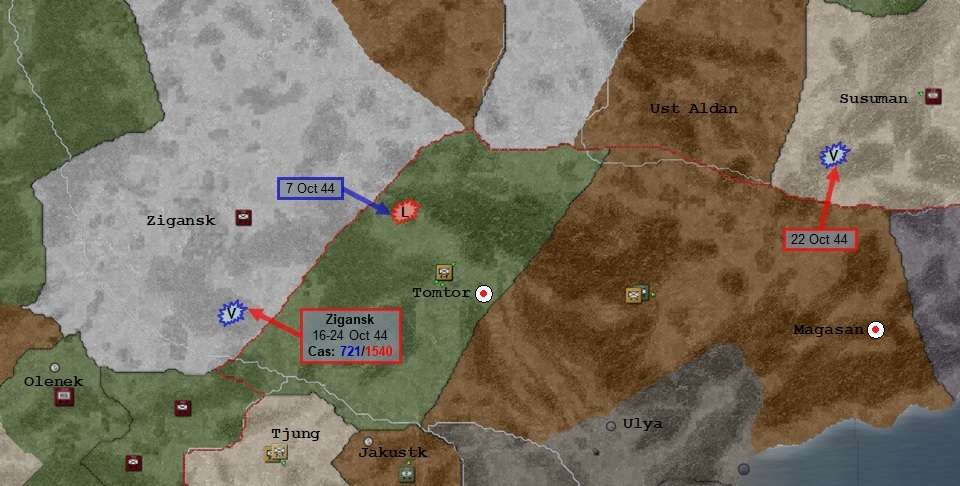
Operational summary, Soviet Far East – Northern Sector, October 1944.
Note: as previously, minor skirmishes and probes (fewer than 100 troops lost on each side) are simply shown with a date, arrow and outcome icon.
2. Far East Land Combat - Central Sector
Again, the heaviest action came in the Central sector (Burtatija has been included in the South for this report). Two battles had been carried over from September: a Soviet attack on Kedrovyy and a Japanese attack on Stanovoe Nagore.
But first, a strong new Soviet attack on Sinyuga was launched at 0000 hr on 1 October 1944. Soviet medium tanks (8 Tank Div) and infantry (23 and 123 SDs) attacked a mixed force of three Axis divisions (marines, militia and cavalry, some already damaged from previous fighting) in a blitzing attack, which the Japanese commander attempted to delay.
An hour later, the Japanese countered just to the north of Sinyuga with their own three-division attack on Sorgo (15 and 69 Mot Divs). This forced the existing Soviet attack on Kedrovyy to be abandoned soon afterwards, before either side had suffered many casualties.
The Soviet attack on Sinyuga proved a great success, with victory on 2 October bringing over 1,100 Japanese dead with around 250 of the attackers falling in the assault. And the rash Japanese attack on Stanovoe Nagore, which had started on 30 September, was beaten off by 2 October, the Japanese suffering heavy casualties (nearly 1,200) at almost ten times the ratio of Soviet defenders lost.
But in Sorgo, the Japanese pressure proved too great to withstand: defeat came on 4 October after three days of intense fighting and heaving casualties among the Soviet defenders (over 1,900 killed) before they retreated.
The first expansion (to Level 2) of the air base at Mutina was installed on 10 October, and the next scheduled straight away, with a high priority.
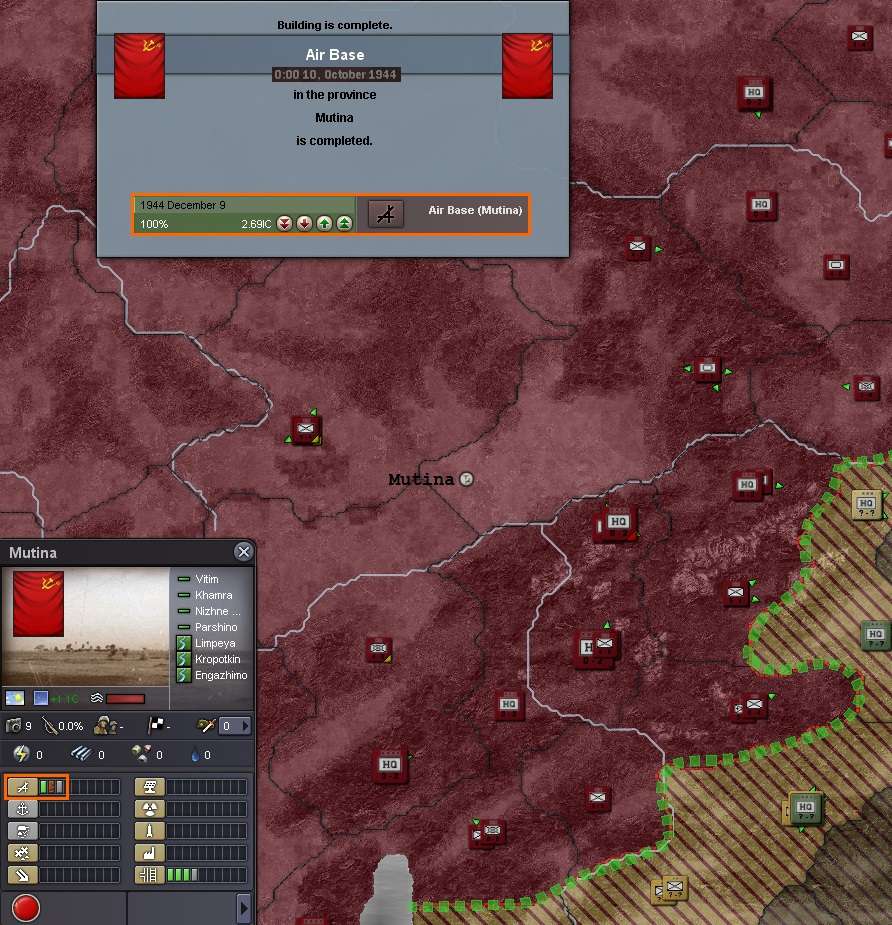
A new battle erupted in Sorgo at 0600 hr on 12 October, when 24 SD arrived before the Japanese could occupy it. They attempted an elastic defence against as assault by the Konoeshidan Guards and 6th Infantry divisions. The fight began as an even match tactically [52%]. But the momentum swung to the Japanese, who achieved a big victory by 14 October, killing over a thousand Soviet defenders for less than half that many casualties themselves.
At 1700 hr on 13 October, a quick Soviet probe on Dronovskiy had found the Japanese defenders who had just slipped in not up to the fight. They fled, as the Soviets advanced to occupy the province.
On 14 October, a probe at 0100 hr by the Japanese on Sinyuga was soon halted after a reckless assault by cavalry on a Soviet light tank division was repulsed with 212 enemy killed for seven Soviet soldiers. Even foolhardy Japanese cavalry officers with a death wish knew when the odds were too great to sustain an attack!
After fighting for it repeatedly, Japanese troops occupied Sorgo with a single infantry division at 0500 hr on 15 October. Only to find themselves under attack from two Soviet rifle divisions an hour later [starting progress 65%]. The battle would continue for another four days, until the Soviets won through after a tough fight on 19 October.
On the night of 16 October, the Soviet 219 Mech Div had rolled into Dronovskiy, only to find itself under attack by two Japanese infantry divisions – though only one of them was fresh. Their shock attack completely negated the Soviets’ attempt to delay them. Outnumbered though fighting in good terrain, the Soviets found themselves at a moderate initial disadvantage [-56%]. But over five days of frantic fighting, the Soviets managed to turn the situation around and on 21 October won a convincing victory, inflicting twice as many casualties as they received.
The Japanese were not done trying to take Sinyuga, attacking again at 0100 hr on 19 October with the Konoeshidan Guards Division. But they came up against the T-34s of the 8th Tank Div and were repulsed heavily after five days of determined but futile attacking.
The fighting in and around Dronovskiy around this time became a confused set of probes and spoiling attacks exchanged between the two adversaries, not amounting to much, but by 21 October it remained in Soviet hands, and would for the end of the month.
24 October saw the most determined Japanese attack yet on Sinyuga just before midnight. The battle was still going at the end of the month, gradually swinging in Japan’s favour. By 0900 hr on 30 October, the defence was in real trouble, though they fought on and 123 SD was just a few days away from joining in.
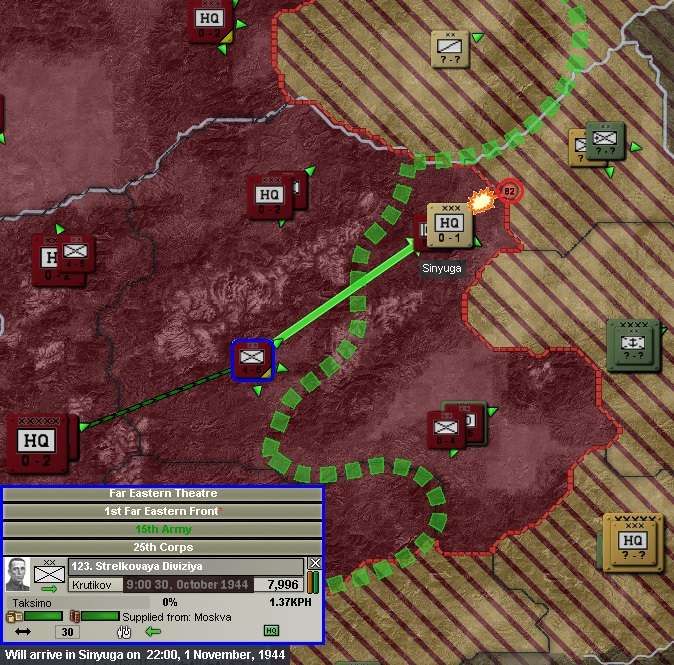
The Soviets were equally determined to retake Sorgo, with another attack kicking off at 1000 hr on 24 October with two rifle divisions against a defending Japanese cavalry division . The Soviets won the battle the next day and still continued their advance by the end of the month.
The Soviets finished the month with a breakthrough attack by 21 Tank Div (medium tanks) on two cavalry divisions, a marine division and four enemy HQs in Novaya Chara at 1300 hr on 27 October. At first the attack seemed a little dubious [54%], but all three enemy divisions were well worn and the Soviets were fresh and determined. By late on 28 October they were blitzing the defenders [67%] and won a useful victory on 29 October.
During this period, no friendly or enemy air sorties were flown in the Central sector.

Operational summary, Soviet Far East – Central Sector, October 1944.
3. Far East Land Combat - Southern Sector
There will be no surprise to learn that the first action in this sector was an unsuccessful Soviet probe on Burjatija on 1 October, mercifully cut short as the casualties began piling up in the first hour. Of more destructive value was the air support that continued for the day, even after the attack was over, killing 612 Japanese defenders.
As the Soviets prepared their plans for the next ‘surprise’ attack (on Burjatija, of course), the promise of extra troops for 7th Army was acknowledged. 26th Corps, on the German border, was topped up to five infantry divisions in strength, detached from the Baltic Theatre and put on trains for the long journey east. They would rendezvous in Wilno first, then travel together as a group to the Far Eastern Front.
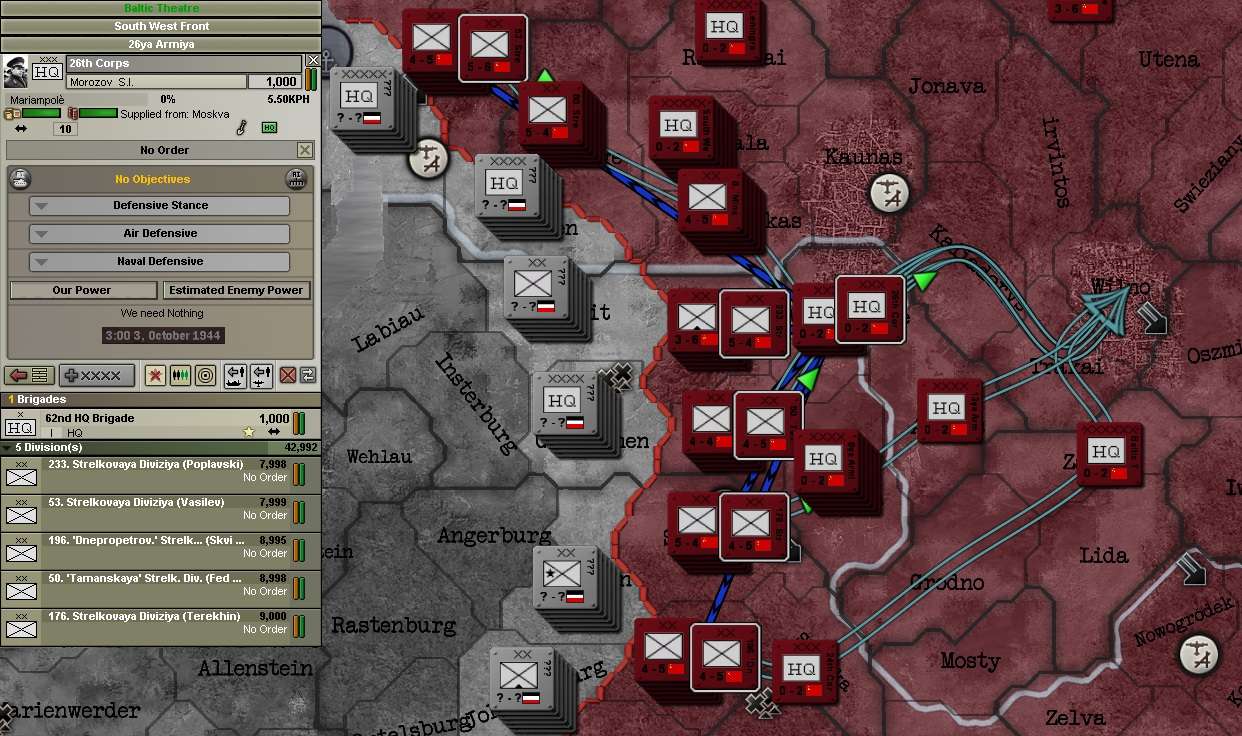
On 5 October, with nothing much happening in Mongolia despite the orders given 7th Army (who considered they had too few troops for the offensive they had been tasked with) and suggestions already passed to the Mongolians, a new offensive objective was set for them.

Having done a ‘reconnaissance in force’ on 1 October, a more determined Soviet attack began (on Burjatija, if it needs to be stated) on 5 October. Hundreds of Soviet planes based in Irkutsk roared overhead to strike the enemy defences for that day and the next, killing an estimated 1,034 defenders. But the result was the same as before, except with more casualties: 454 Soviet attackers to 213 Japanese defenders were killed before the attack was called off on 6 October.
As 1st Army licked its wounds and 7th Army and the Mongolians did very little, another new mechanised division was deployed from training on 16 October. It was assigned to the newly activated 4th Mech Corps, which had been sitting in reserve at Oka, under 7th Army and began work-up just south of Irkutsk.
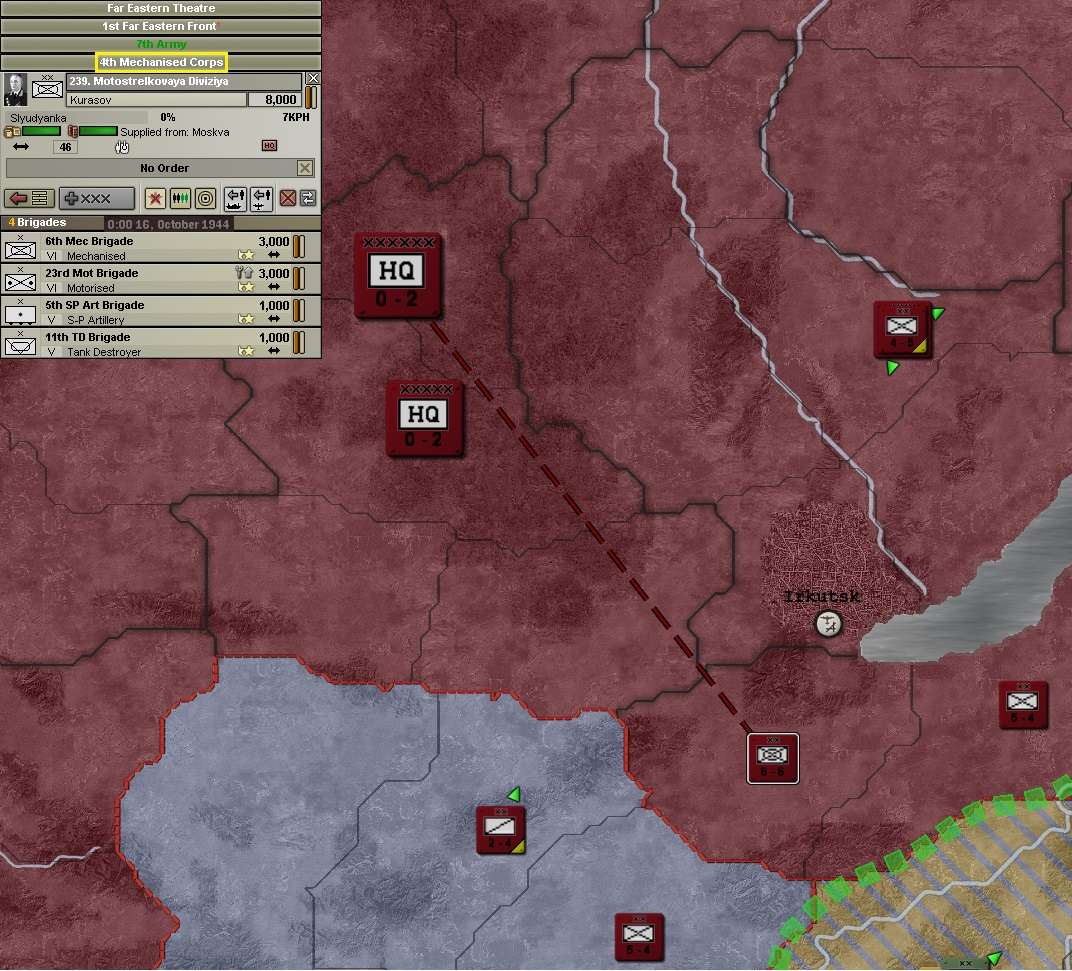
The Level 6 expansion to Irkutsk air base was delivered on 18 October and the next improvement set in train straight away at the crowded airfield – the busiest in the Far East.
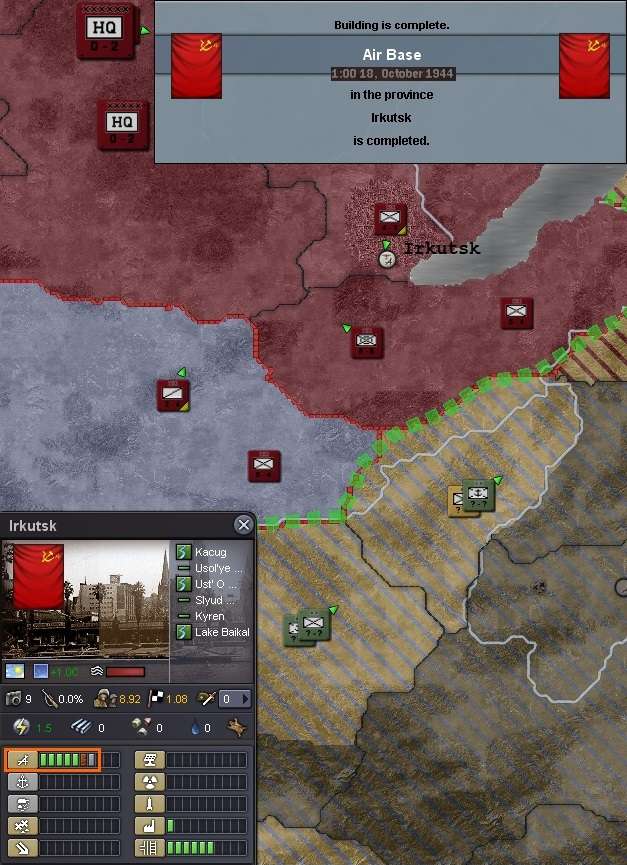
1st Army decided to send a probe on 27 October to see if the defences of Burjatija were as strongly held as they had been the many times they had been attacked previously. They were: the probe was called off straight away – though not before a single (almost token) air raid had killed 166 Japanese defenders. Just to keep them on their toes.
Meanwhile, 7th Army and Mongolian indolence further south had allowed the Japanese to advance unhindered into Tszag, another province adjoining the temporary capital of Uliastay. It was held strongly enough, but this provocation could not be tolerated. By the Theatre Commander Marshal Garnov, anyway. A new suggestion was sent to the Mongolian commanders to retake Tszag – though there was no guarantee they would take any notice.
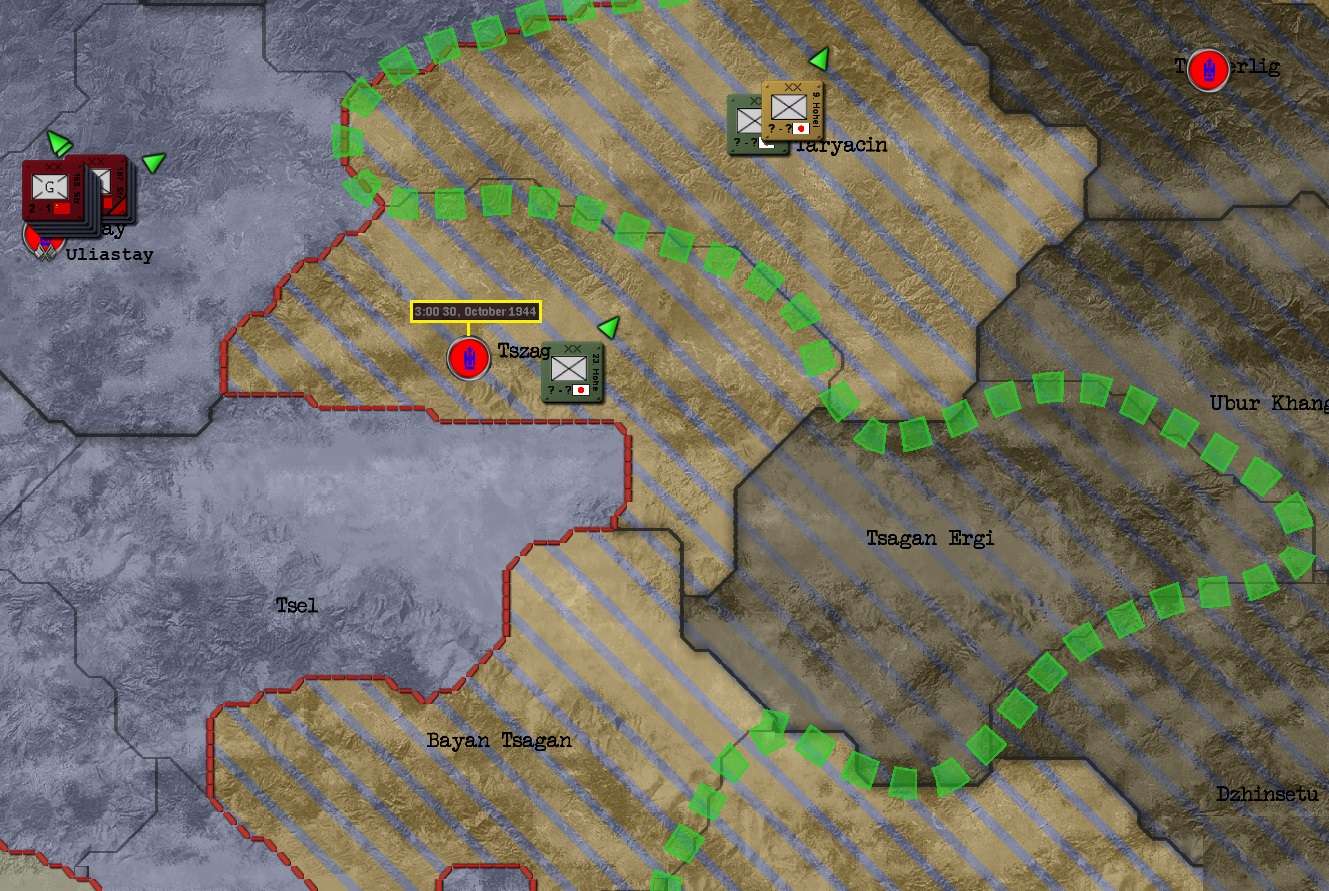
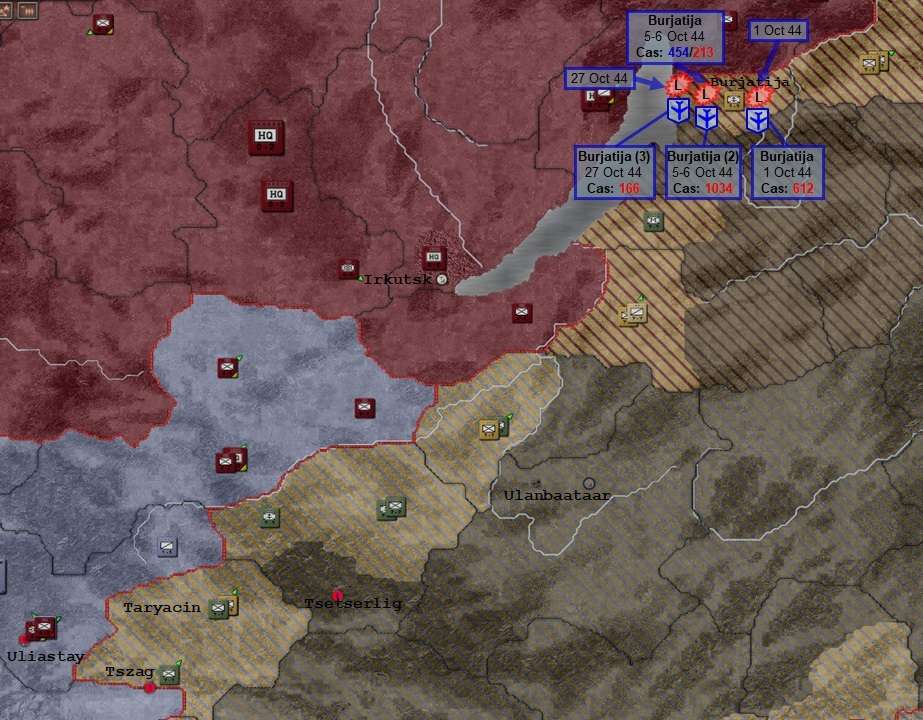
Operational summary, Soviet Far East – Southern Sector, October 1944.
4. Persia
There were no battles and no territory changed hands in Persia for the whole of October. Perhaps the Front Commander was waiting for all his forces on trains to the eastern sector to be in place before advancing again. If so, he may be getting a displeased visitor from STAVKA soon to find out why he refused to attack an outnumbered enemy.

******
5. Naval Operations
Soviet submarine operations got off to a slow start, with only two convoys sunk in the first half of the month. But it finished on a high note in the second, with another seven sunk to make it nine Japanese convoys for the month, again with little to challenge the Soviet submariners in their clunky old boats.
6. Diplomatic and Intelligence
On 8 October, Sweden decided to balance the Axis and Allied influence on its alignment by moving itself more towards the Comintern orbit. The Asian superpower (ahem) of Tibet was also seeking closer Comintern ties, while Soviet influence continued on Spain, Turkey and Nationalist China (the latter under review after some in the Foreign Ministry expressed doubts as to its value).
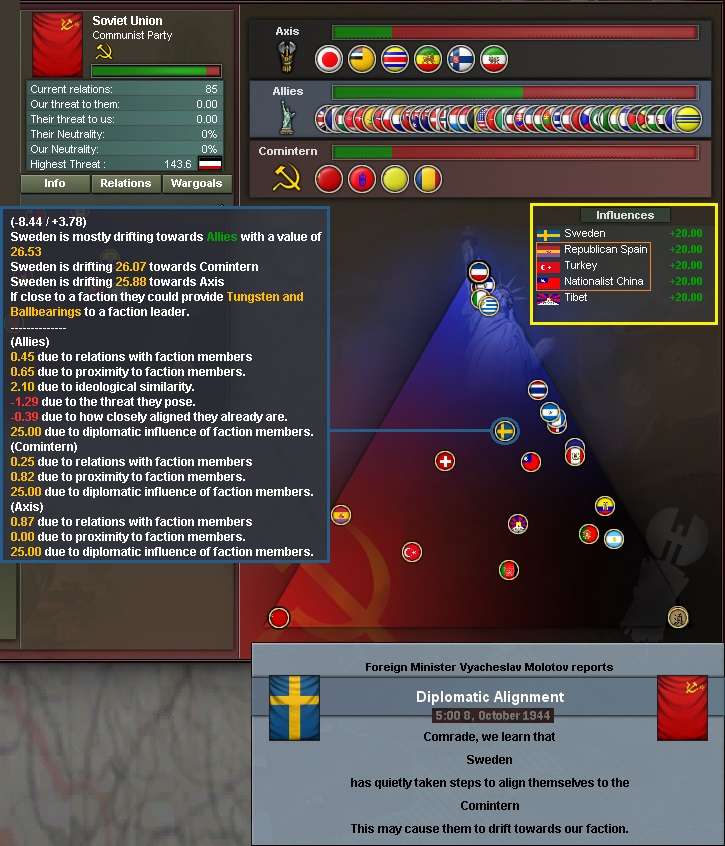
Alas, Tibet stopped its alignment two days after this.
The NKVD reported later in the month that a Finnish guerrilla cell had formed in Kalliosalmi, but they were not yet showing their hand.
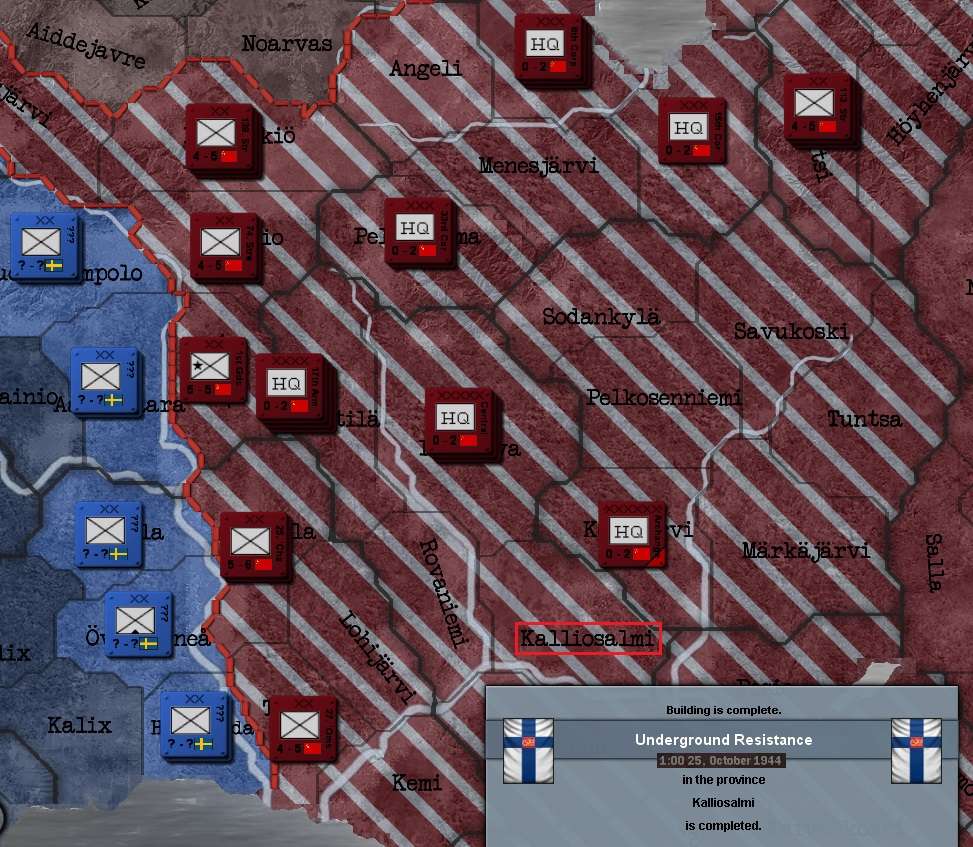
And after a quiet month in Manchukuo, a Soviet spy team was apprehended on 29 October. A review showed these Japanese puppets had managed to build up a small domestic counter-espionage capability again. In response, Soviet agents were ordered to split their efforts between counter-espionage and the disruption of national unity they had been concentrating on in recent weeks. The reports that this had sharply fallen to under 60% were not believed, however.
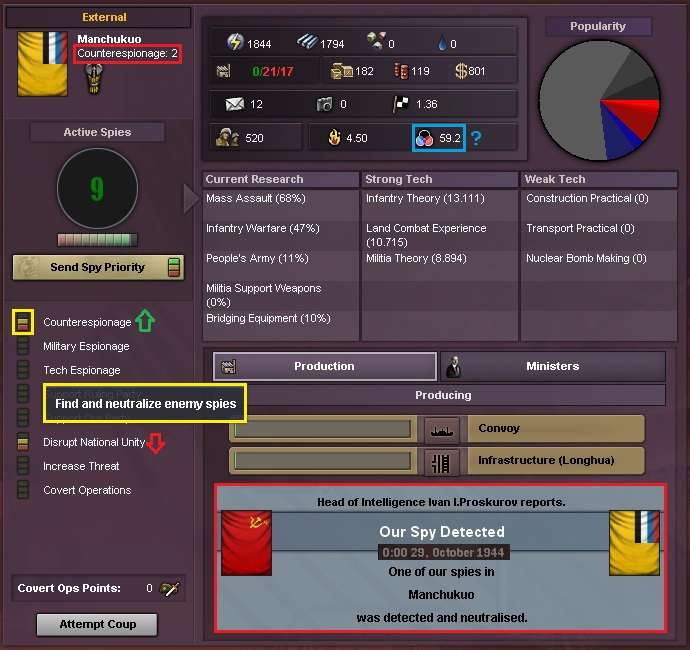
In Japan, the Kempeitai had started the month with two teams and then added another three. But by the end of the month, the Soviets had eliminated all five, losing two teams doing it. Manchukuo had started with no agents but finished with two, losing none and eliminating the one Soviet team mentioned above. Their national unity was assessed to have decreased slightly from 72.3% to 70% by the end of the month [I tagged briefly to determine this, as the estimate of around 59% on the intel screen was pretty absurd].
The Soviets had also taken heavy losses in this struggle. They had lost the three teams overseas, while only producing an extra five in the month. They maintained a full 10-team presence at home and in Japan and Manchukuo, and were now back up to eight in reserve, two higher in total from the end of September. The usual diverse swag of other foreign spies was also apprehended during the month sniffing around the Soviet Union.
7. Research
With the efficiency of Soviet industry improved again on 10 October, the great program to modernise the air force was continued, this time an improvement to the antiquated Great War era training for TAC bomber ground crews.
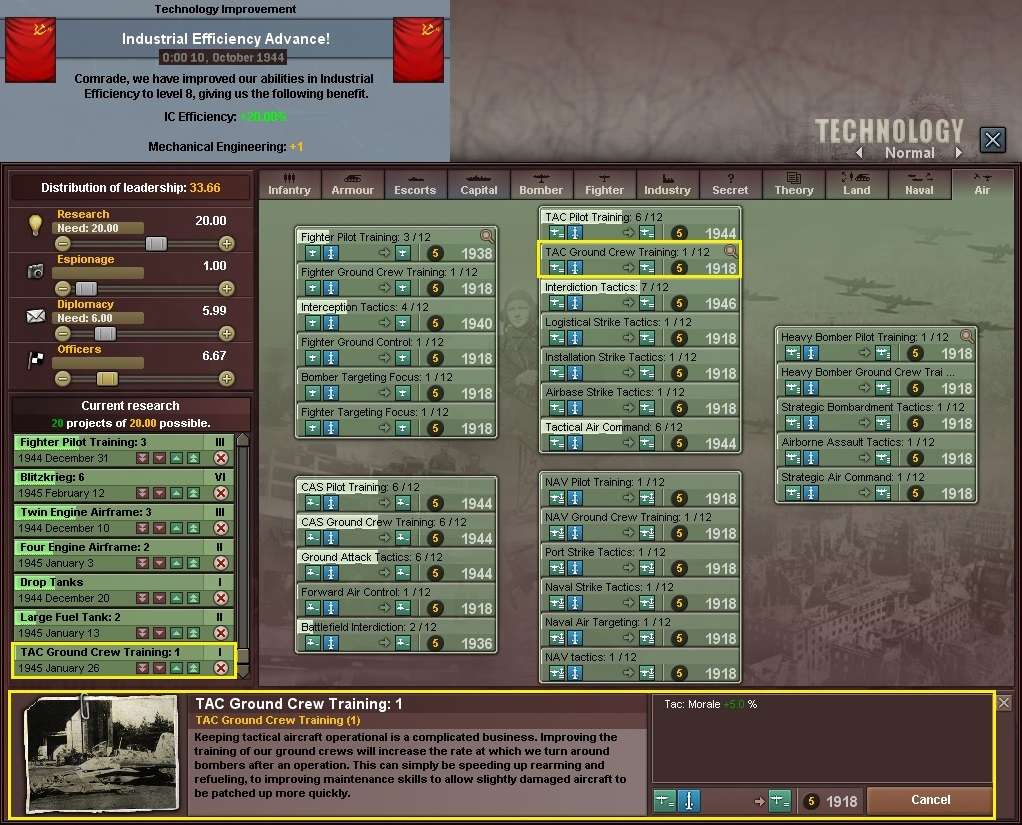
The next day, night fighting equipment was introduced for infantry formations. But for some strange reason, it was not usable for motorised or mechanised infantry brigades, nor any armour-based formations. Still, it should be of some assistance for night attacks, once fully introduced. Out of date fighter ground crew training was the next area targeted for doctrine research.
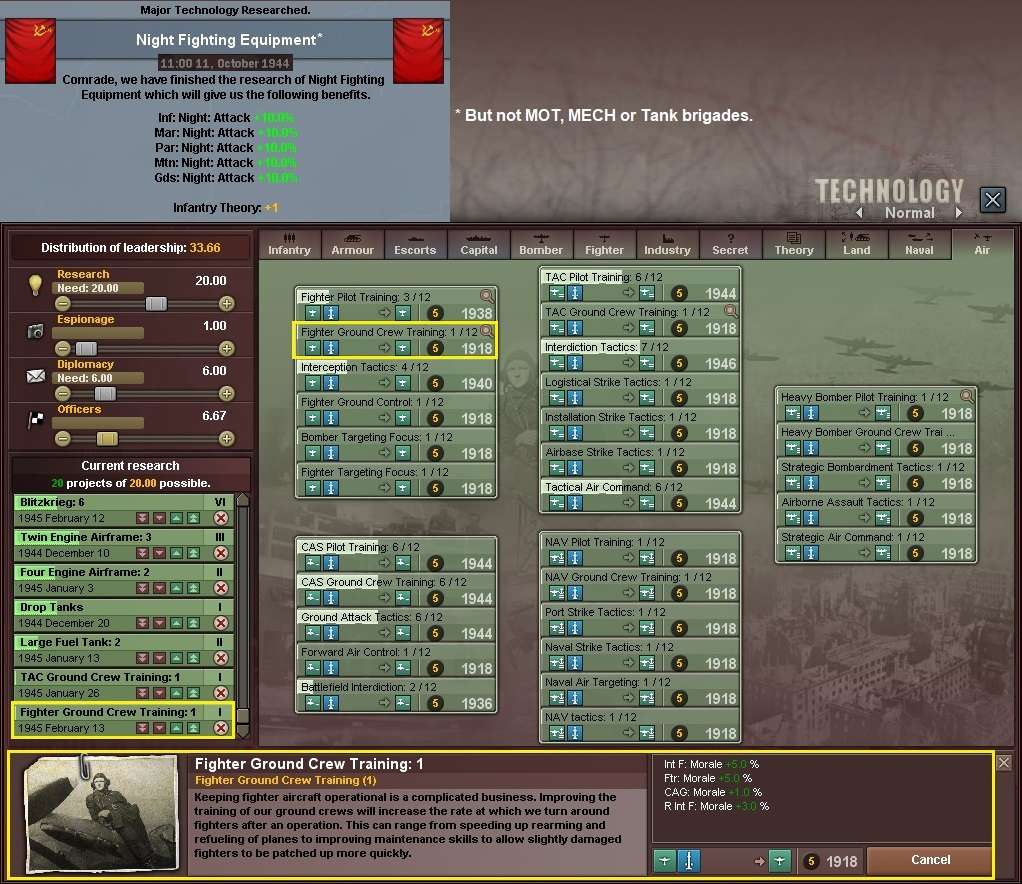
On 20 October supply transportation was improved – and that had assisted in the significant reduction of the supply demand in recent weeks (well down from the earlier peaks, allowing more to go back into the production queue, after upgrades were accounted for). It was decided to give the USSR’s special forces improved training as the next research priority.
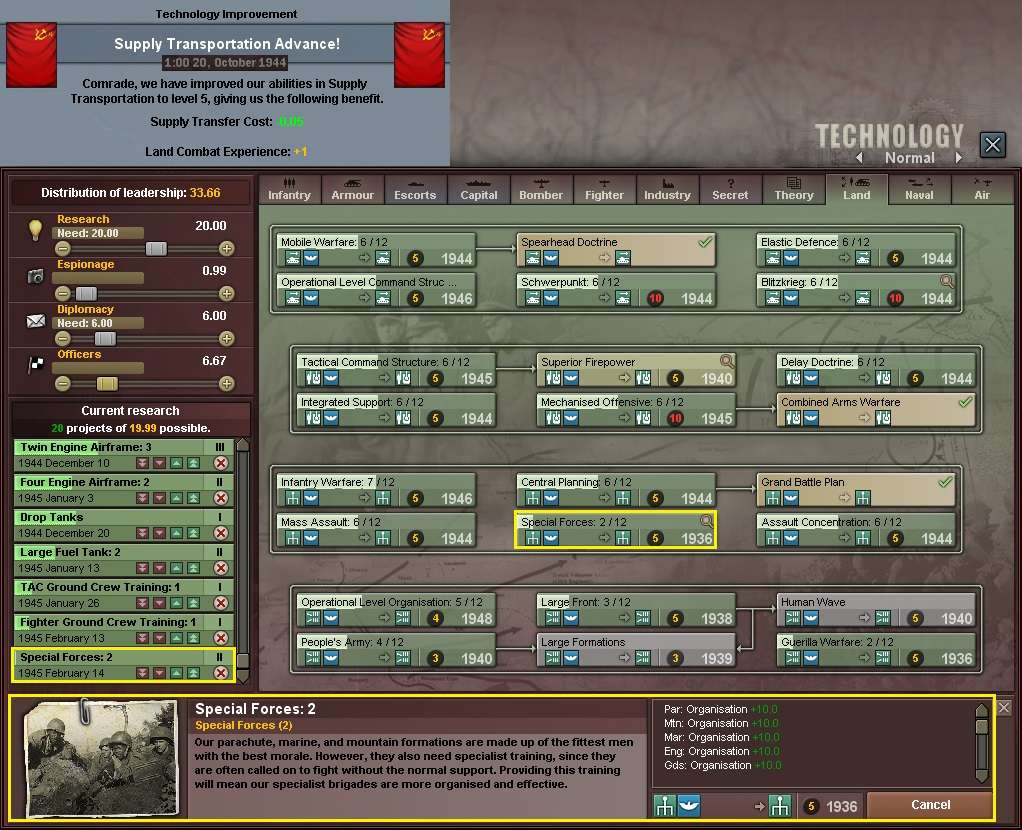
An advance in aero engine design enabled better performance though at a range penalty for all aircraft types. The loss of range would need to be offset by complementary research on fuel tanks. It was decided to keep research going on aero engines, as Soviet designers had mentioned the possibility of a new class of aircraft – helicopters – being developed for battlefield use, especially for medical evacuation. Single engine airframe design would also need to be improved at the next opportunity to enable that breakthrough to be researched.
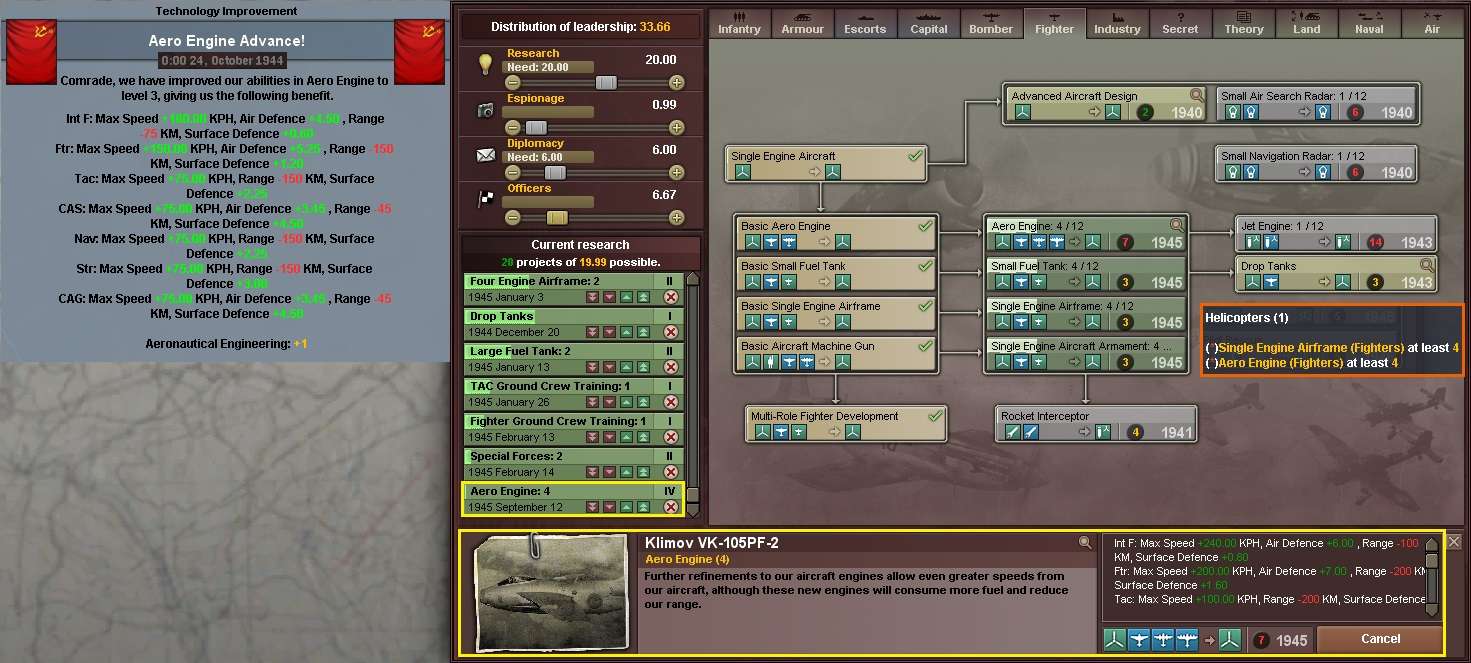
******
8. Global Summaries
The Far East had seen some change of territory in both directions – the most promising for the Soviets being in the Central sector, while the Northern and Southern sectors had seen Japanese advances, though in more marginal and lightly held areas.
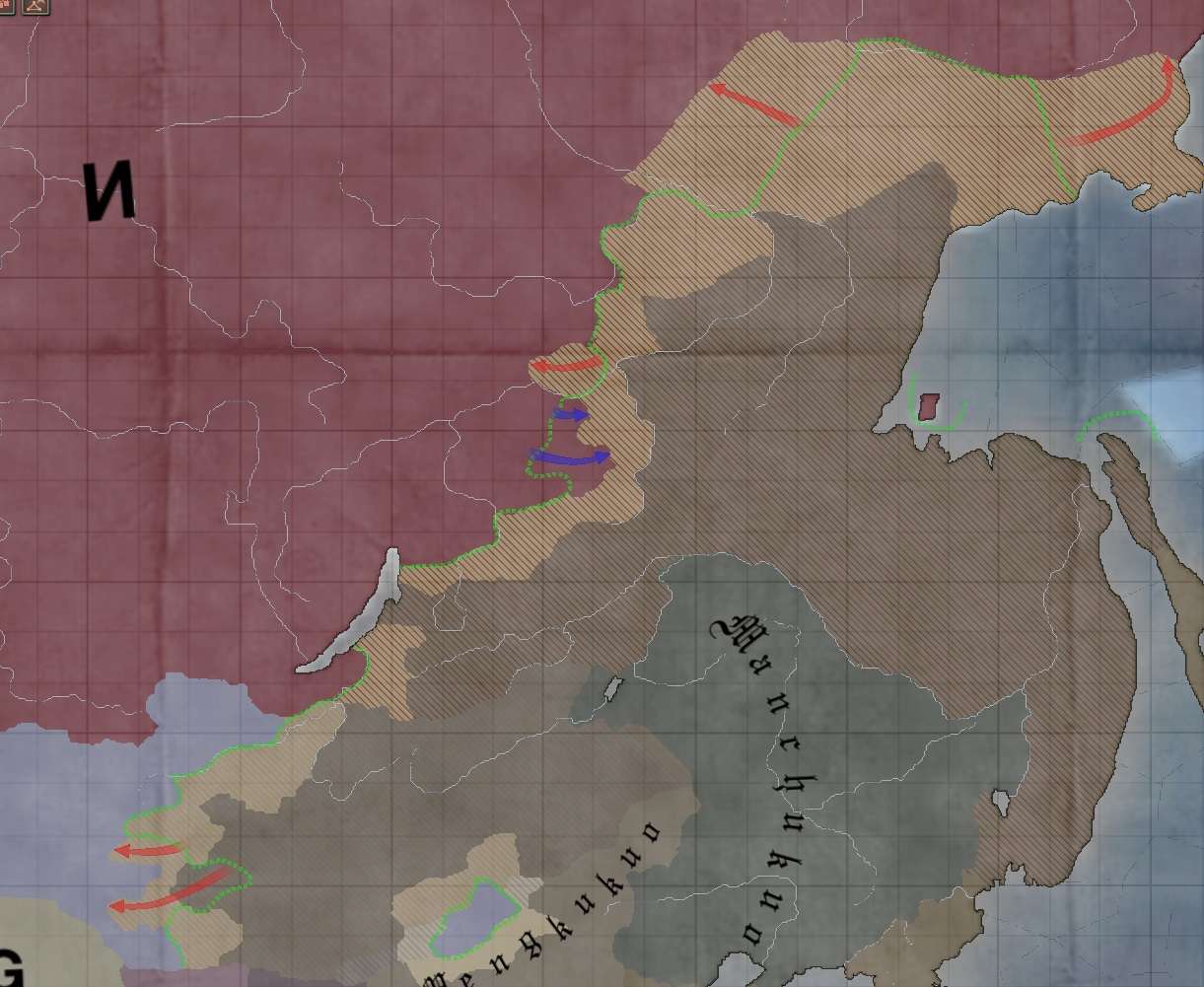
Total recorded losses to land combat for battles in which the Soviets were involved were 7,221 against 11,001 Axis soldiers killed. There were no Soviet losses from air raids, while a far lower intensity of air operations saw only 1,812 Axis soldiers killed in October. They seemed unwilling to engage in interdiction of enemy attacks with ground strikes, despite general orders for an offensive air stance. Total combat losses for the USSR were therefore 7,221, with the Axis losing 12,813.
The Allies had made significant advances into resource-rich Sumatra and western Java, but the Japanese had gained ground in Indo-China and had made a surprise new landing in eastern Java.
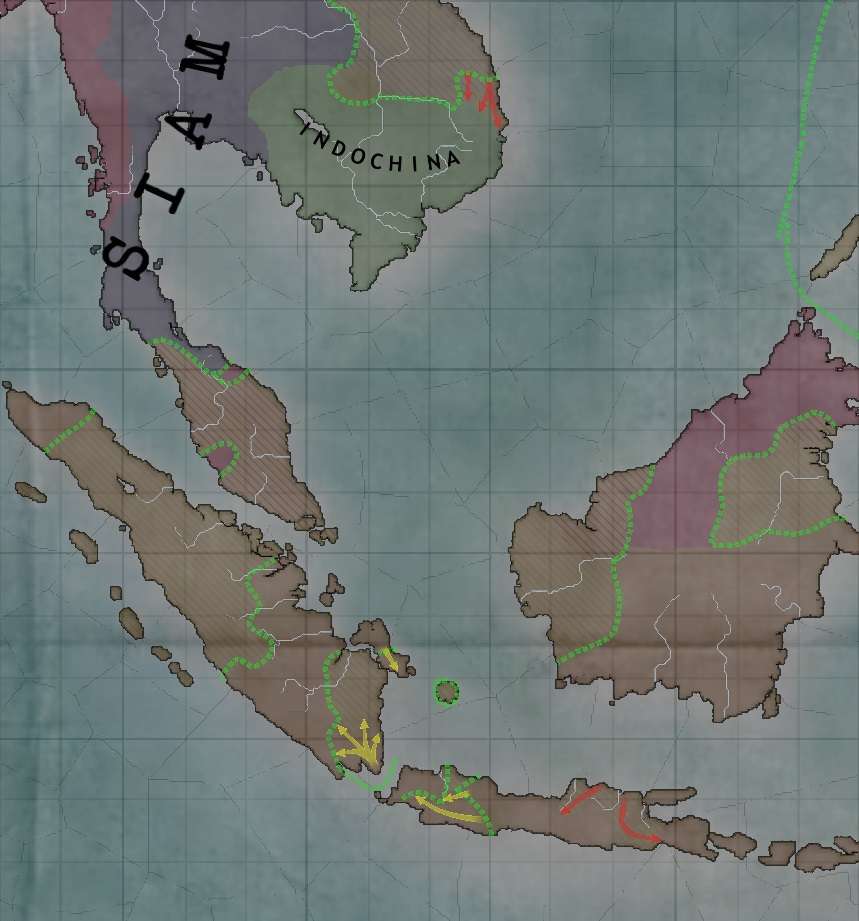
Despite having strong forces in Indo-China, the Allies had problems holding their lines in October. The place was crawling with Japanese marine divisions.
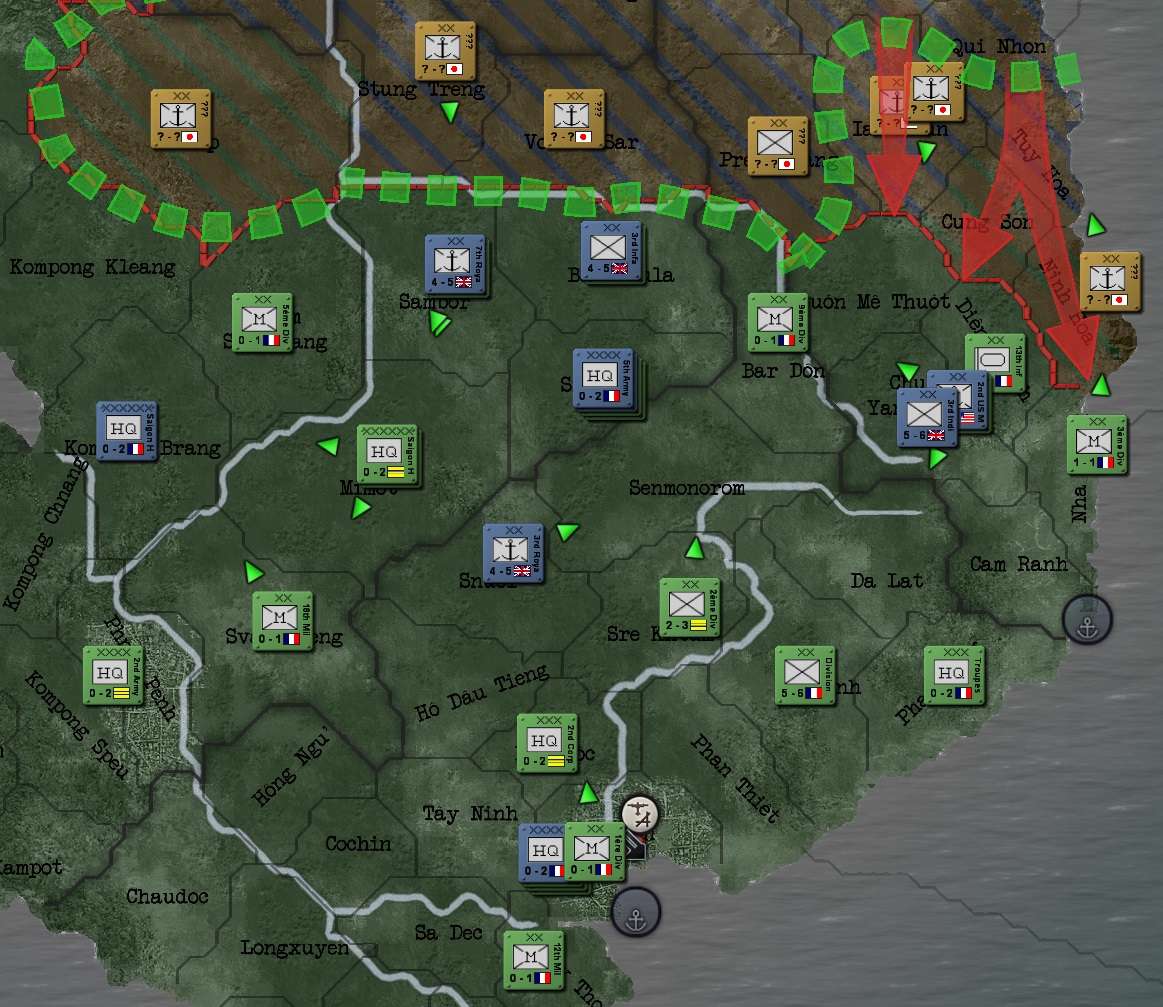
British marines had successfully crossed the Sunda Strait and begun to liberate southern Sumatra for the Dutch. And a guerrilla uprising in the north had taken advantage of Japanese distraction.
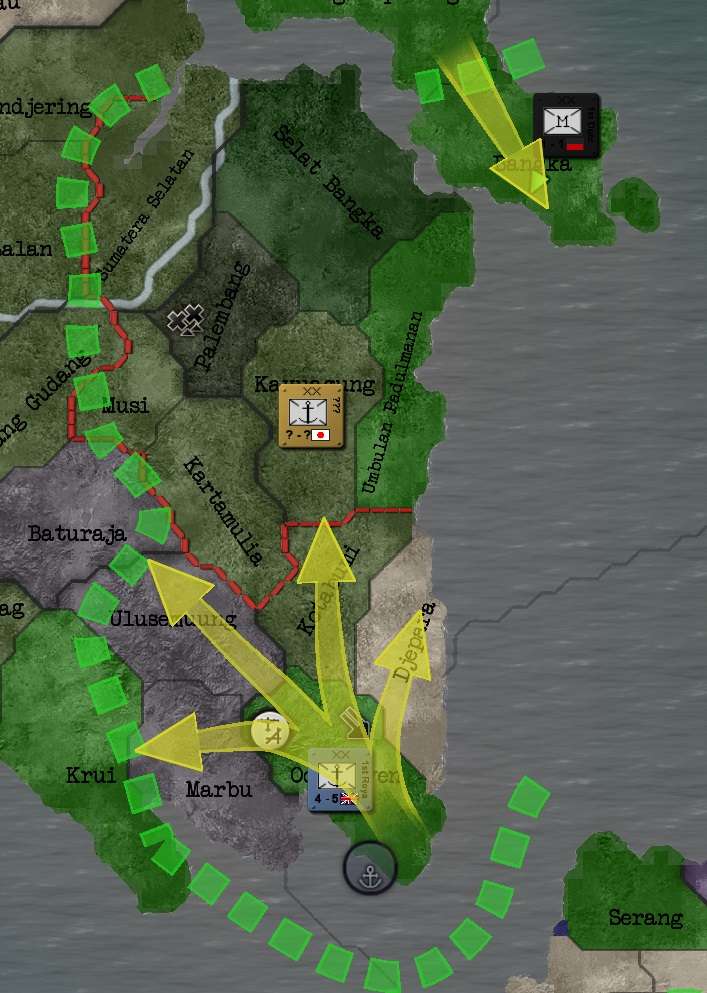
But while the Dutch had continued to mop up western Java, they had been surprised by a new Japanese invasion of eastern Java, cutting off their HQ in Soerabaya: but the Japanese had not yet captured a port for resupplying their landed forces.

******
In Australia, Adelaide had been lost, but counter-attacks in Victoria had given acting capital of Melbourne a buffer zone.
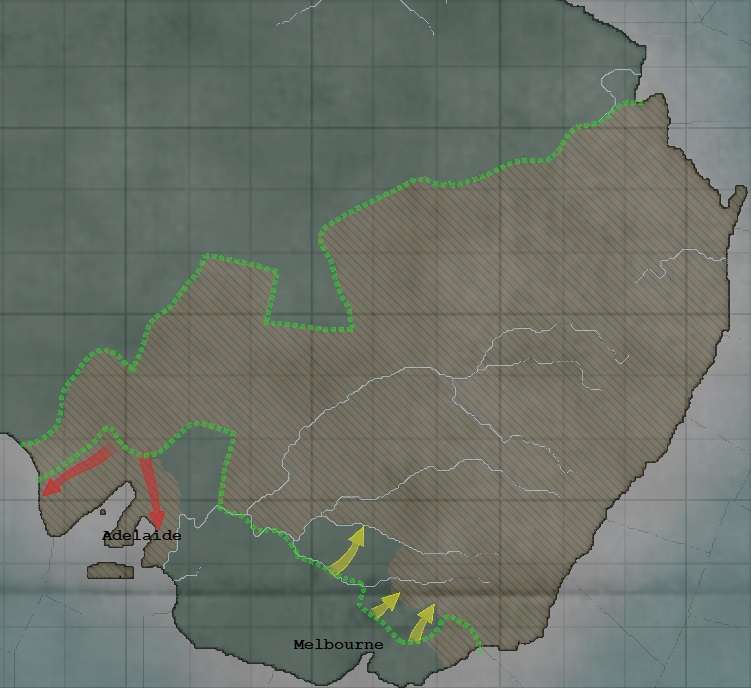
The US 82nd Airborne in the north and Australian units near Melbourne, with heavy air support in place, had made some gains during the month.
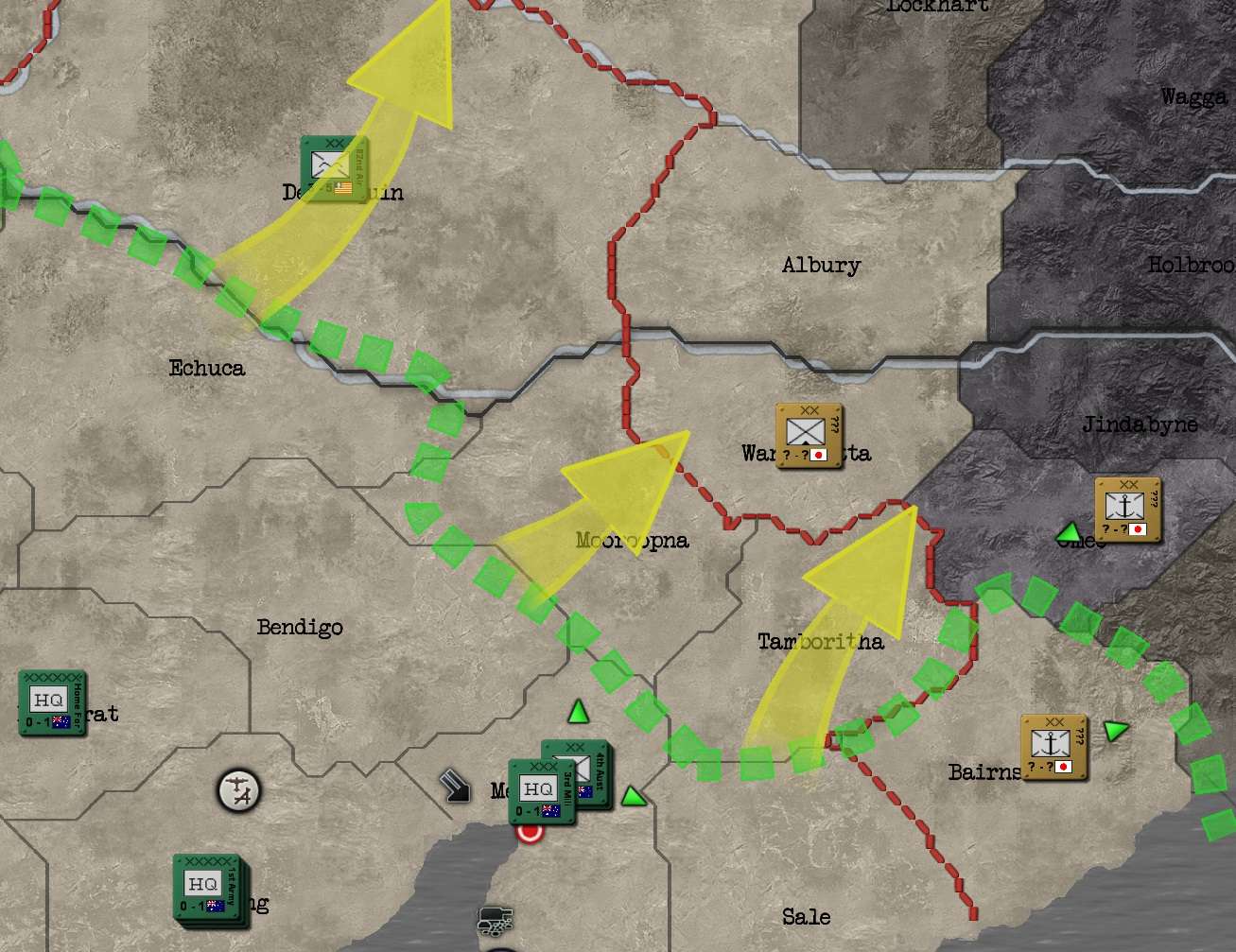
While there had again been no change – or any obvious sign of US activity – in the Central Pacific.
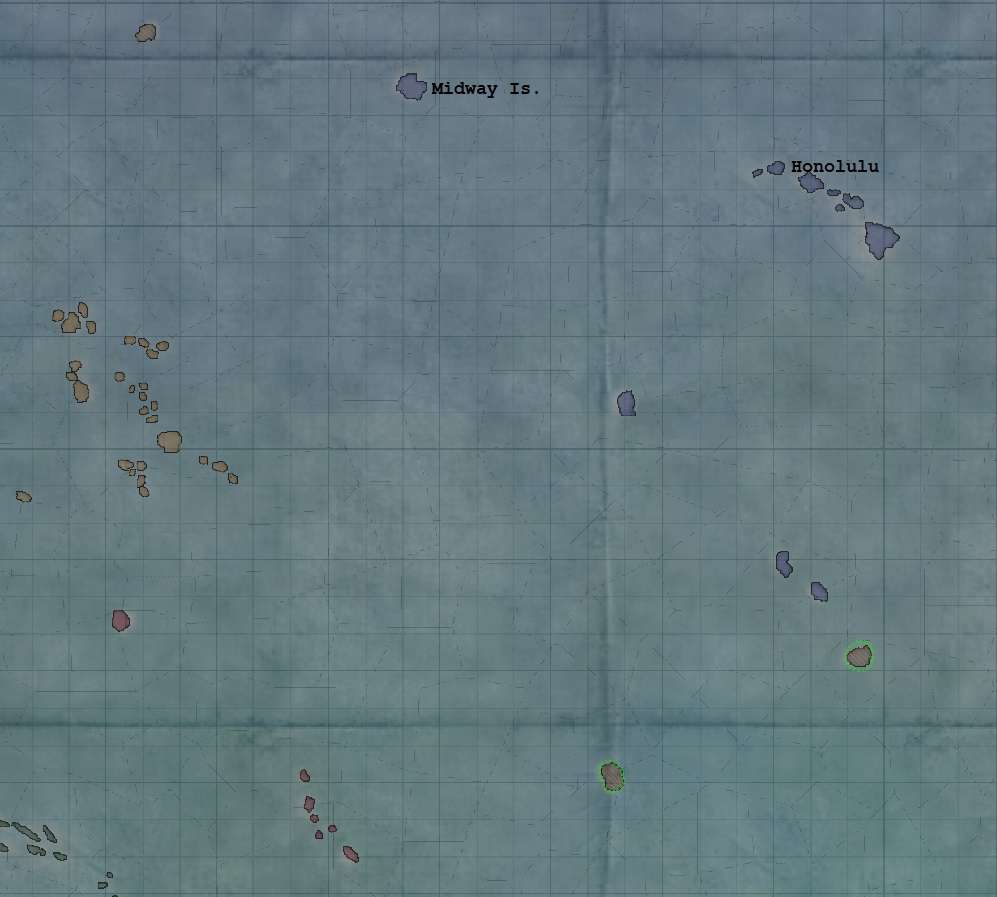
AuthAAR’s Notes: The game behaved itself impeccably – I may be through the period of gremlins (he says boldly, thereby tempting fate).
******
1. Far East Land Combat - Northern Sector
The 6th Army was slowly beginning to exert its influence in the far north of the front, but it was a time-consuming process given the distances and terrain. There were a couple of probes and one major battle in the sector during October.
The Japanese finally occupied Tomtor at 0400 hr on 7 October, following up their victory there in September. A short skirmish occurred when an approaching Soviet troop column bumped into the newly arrived Japanese division, but was soon broken off. Magasan, a remote province on the Pacific coast, fell at 0400 hr on 13 October.
The largest battle during the month in the north began at 1300 hr on 16 October, when the Japanese marines of 9th Rikusentai attacked 129 SD in Zigansk. While the Soviets had about 2,000 troops fewer than their attackers, they were dug in on favourable terrain and had the tactical advantage [-36% for the attackers]. After eight days of grim fighting, the Japanese attack was defeated with heavy casualties.
An enemy approach on Susuman was blocked by the arrival of Soviet troops on 22 October, where a couple of soldiers were killed in a skirmish before the Japanese withdrew. The Soviet division then kept moving to their assigned objective of Ust Aldan.
And Commander 6th Army was given a new wing of each of TAC and INT (temporarily combined for work-up, though their ranges are not ideally matched) on 27 October at the primitive and overcrowded air base in Olonek. Not that any aircraft from either side flew any missions during the whole of the month.


Operational summary, Soviet Far East – Northern Sector, October 1944.
Note: as previously, minor skirmishes and probes (fewer than 100 troops lost on each side) are simply shown with a date, arrow and outcome icon.
******
2. Far East Land Combat - Central Sector
Again, the heaviest action came in the Central sector (Burtatija has been included in the South for this report). Two battles had been carried over from September: a Soviet attack on Kedrovyy and a Japanese attack on Stanovoe Nagore.
But first, a strong new Soviet attack on Sinyuga was launched at 0000 hr on 1 October 1944. Soviet medium tanks (8 Tank Div) and infantry (23 and 123 SDs) attacked a mixed force of three Axis divisions (marines, militia and cavalry, some already damaged from previous fighting) in a blitzing attack, which the Japanese commander attempted to delay.
An hour later, the Japanese countered just to the north of Sinyuga with their own three-division attack on Sorgo (15 and 69 Mot Divs). This forced the existing Soviet attack on Kedrovyy to be abandoned soon afterwards, before either side had suffered many casualties.
The Soviet attack on Sinyuga proved a great success, with victory on 2 October bringing over 1,100 Japanese dead with around 250 of the attackers falling in the assault. And the rash Japanese attack on Stanovoe Nagore, which had started on 30 September, was beaten off by 2 October, the Japanese suffering heavy casualties (nearly 1,200) at almost ten times the ratio of Soviet defenders lost.
But in Sorgo, the Japanese pressure proved too great to withstand: defeat came on 4 October after three days of intense fighting and heaving casualties among the Soviet defenders (over 1,900 killed) before they retreated.
The first expansion (to Level 2) of the air base at Mutina was installed on 10 October, and the next scheduled straight away, with a high priority.

At 1700 hr on 13 October, a quick Soviet probe on Dronovskiy had found the Japanese defenders who had just slipped in not up to the fight. They fled, as the Soviets advanced to occupy the province.
On 14 October, a probe at 0100 hr by the Japanese on Sinyuga was soon halted after a reckless assault by cavalry on a Soviet light tank division was repulsed with 212 enemy killed for seven Soviet soldiers. Even foolhardy Japanese cavalry officers with a death wish knew when the odds were too great to sustain an attack!
After fighting for it repeatedly, Japanese troops occupied Sorgo with a single infantry division at 0500 hr on 15 October. Only to find themselves under attack from two Soviet rifle divisions an hour later [starting progress 65%]. The battle would continue for another four days, until the Soviets won through after a tough fight on 19 October.
On the night of 16 October, the Soviet 219 Mech Div had rolled into Dronovskiy, only to find itself under attack by two Japanese infantry divisions – though only one of them was fresh. Their shock attack completely negated the Soviets’ attempt to delay them. Outnumbered though fighting in good terrain, the Soviets found themselves at a moderate initial disadvantage [-56%]. But over five days of frantic fighting, the Soviets managed to turn the situation around and on 21 October won a convincing victory, inflicting twice as many casualties as they received.
The Japanese were not done trying to take Sinyuga, attacking again at 0100 hr on 19 October with the Konoeshidan Guards Division. But they came up against the T-34s of the 8th Tank Div and were repulsed heavily after five days of determined but futile attacking.
The fighting in and around Dronovskiy around this time became a confused set of probes and spoiling attacks exchanged between the two adversaries, not amounting to much, but by 21 October it remained in Soviet hands, and would for the end of the month.
24 October saw the most determined Japanese attack yet on Sinyuga just before midnight. The battle was still going at the end of the month, gradually swinging in Japan’s favour. By 0900 hr on 30 October, the defence was in real trouble, though they fought on and 123 SD was just a few days away from joining in.

The Soviets finished the month with a breakthrough attack by 21 Tank Div (medium tanks) on two cavalry divisions, a marine division and four enemy HQs in Novaya Chara at 1300 hr on 27 October. At first the attack seemed a little dubious [54%], but all three enemy divisions were well worn and the Soviets were fresh and determined. By late on 28 October they were blitzing the defenders [67%] and won a useful victory on 29 October.
During this period, no friendly or enemy air sorties were flown in the Central sector.

Operational summary, Soviet Far East – Central Sector, October 1944.
******
3. Far East Land Combat - Southern Sector
There will be no surprise to learn that the first action in this sector was an unsuccessful Soviet probe on Burjatija on 1 October, mercifully cut short as the casualties began piling up in the first hour. Of more destructive value was the air support that continued for the day, even after the attack was over, killing 612 Japanese defenders.
As the Soviets prepared their plans for the next ‘surprise’ attack (on Burjatija, of course), the promise of extra troops for 7th Army was acknowledged. 26th Corps, on the German border, was topped up to five infantry divisions in strength, detached from the Baltic Theatre and put on trains for the long journey east. They would rendezvous in Wilno first, then travel together as a group to the Far Eastern Front.


As 1st Army licked its wounds and 7th Army and the Mongolians did very little, another new mechanised division was deployed from training on 16 October. It was assigned to the newly activated 4th Mech Corps, which had been sitting in reserve at Oka, under 7th Army and began work-up just south of Irkutsk.


Meanwhile, 7th Army and Mongolian indolence further south had allowed the Japanese to advance unhindered into Tszag, another province adjoining the temporary capital of Uliastay. It was held strongly enough, but this provocation could not be tolerated. By the Theatre Commander Marshal Garnov, anyway. A new suggestion was sent to the Mongolian commanders to retake Tszag – though there was no guarantee they would take any notice.


Operational summary, Soviet Far East – Southern Sector, October 1944.
******
4. Persia
There were no battles and no territory changed hands in Persia for the whole of October. Perhaps the Front Commander was waiting for all his forces on trains to the eastern sector to be in place before advancing again. If so, he may be getting a displeased visitor from STAVKA soon to find out why he refused to attack an outnumbered enemy.

******
5. Naval Operations
Soviet submarine operations got off to a slow start, with only two convoys sunk in the first half of the month. But it finished on a high note in the second, with another seven sunk to make it nine Japanese convoys for the month, again with little to challenge the Soviet submariners in their clunky old boats.
******
6. Diplomatic and Intelligence
On 8 October, Sweden decided to balance the Axis and Allied influence on its alignment by moving itself more towards the Comintern orbit. The Asian superpower (ahem) of Tibet was also seeking closer Comintern ties, while Soviet influence continued on Spain, Turkey and Nationalist China (the latter under review after some in the Foreign Ministry expressed doubts as to its value).

The NKVD reported later in the month that a Finnish guerrilla cell had formed in Kalliosalmi, but they were not yet showing their hand.


The Soviets had also taken heavy losses in this struggle. They had lost the three teams overseas, while only producing an extra five in the month. They maintained a full 10-team presence at home and in Japan and Manchukuo, and were now back up to eight in reserve, two higher in total from the end of September. The usual diverse swag of other foreign spies was also apprehended during the month sniffing around the Soviet Union.
******
7. Research
With the efficiency of Soviet industry improved again on 10 October, the great program to modernise the air force was continued, this time an improvement to the antiquated Great War era training for TAC bomber ground crews.




******
8. Global Summaries
The Far East had seen some change of territory in both directions – the most promising for the Soviets being in the Central sector, while the Northern and Southern sectors had seen Japanese advances, though in more marginal and lightly held areas.

******
The Allies had made significant advances into resource-rich Sumatra and western Java, but the Japanese had gained ground in Indo-China and had made a surprise new landing in eastern Java.




******
In Australia, Adelaide had been lost, but counter-attacks in Victoria had given acting capital of Melbourne a buffer zone.



The US fleet might be sitting in a size 1 port, never being able to supply or repair.
The entire front is all much of a muchness. Loss of an Adelaide here, saving a Melbourne there.
An advance in aero engine design enabled better performance though at a range penalty for all aircraft types. The loss of range would need to be offset by complementary research on fuel tanks. It was decided to keep research going on aero engines, as Soviet designers had mentioned the possibility of a new class of aircraft – helicopters – being developed for battlefield use, especially for medical evacuation. Single engine airframe design would also need to be improved at the next opportunity to enable that breakthrough to be researched.
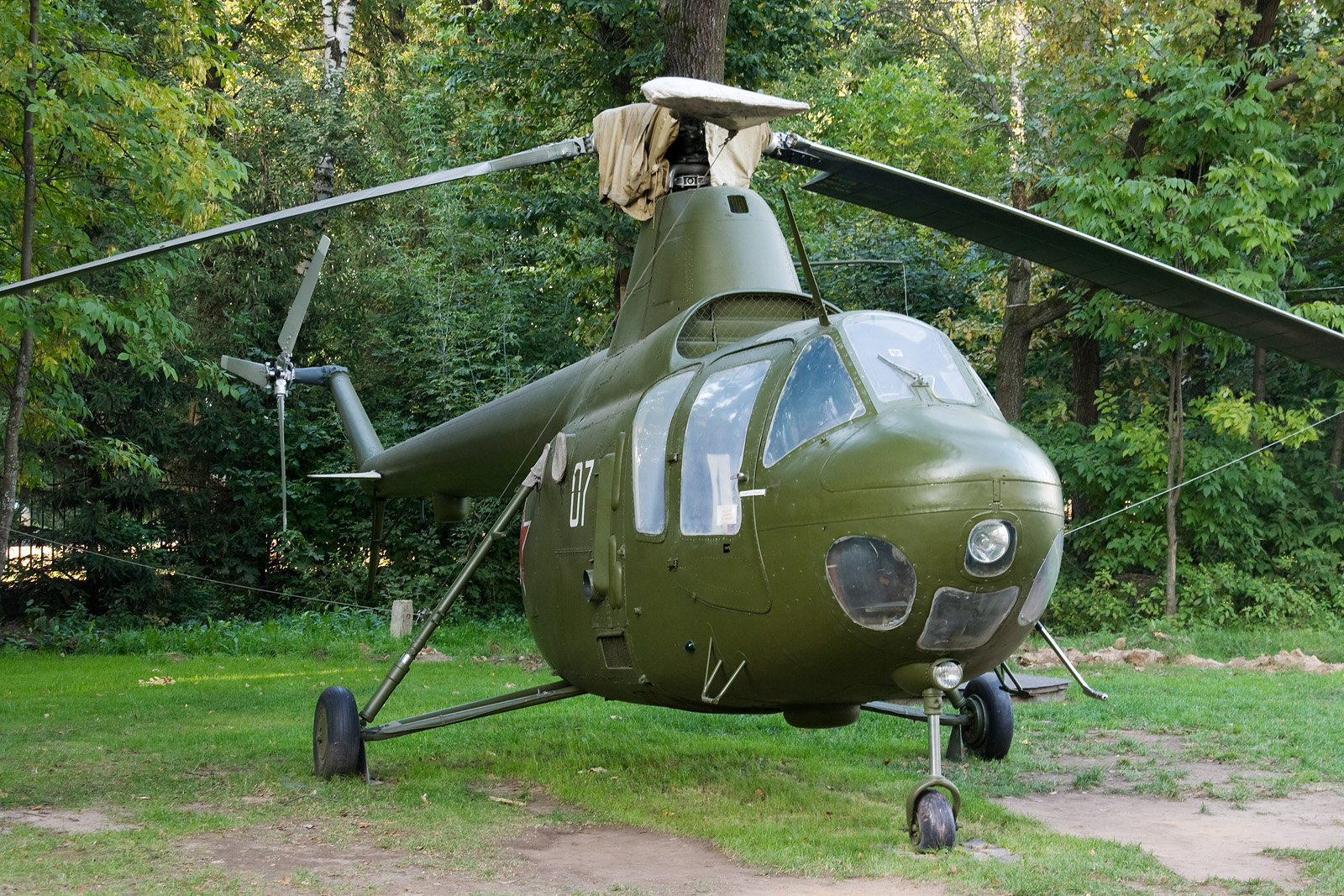
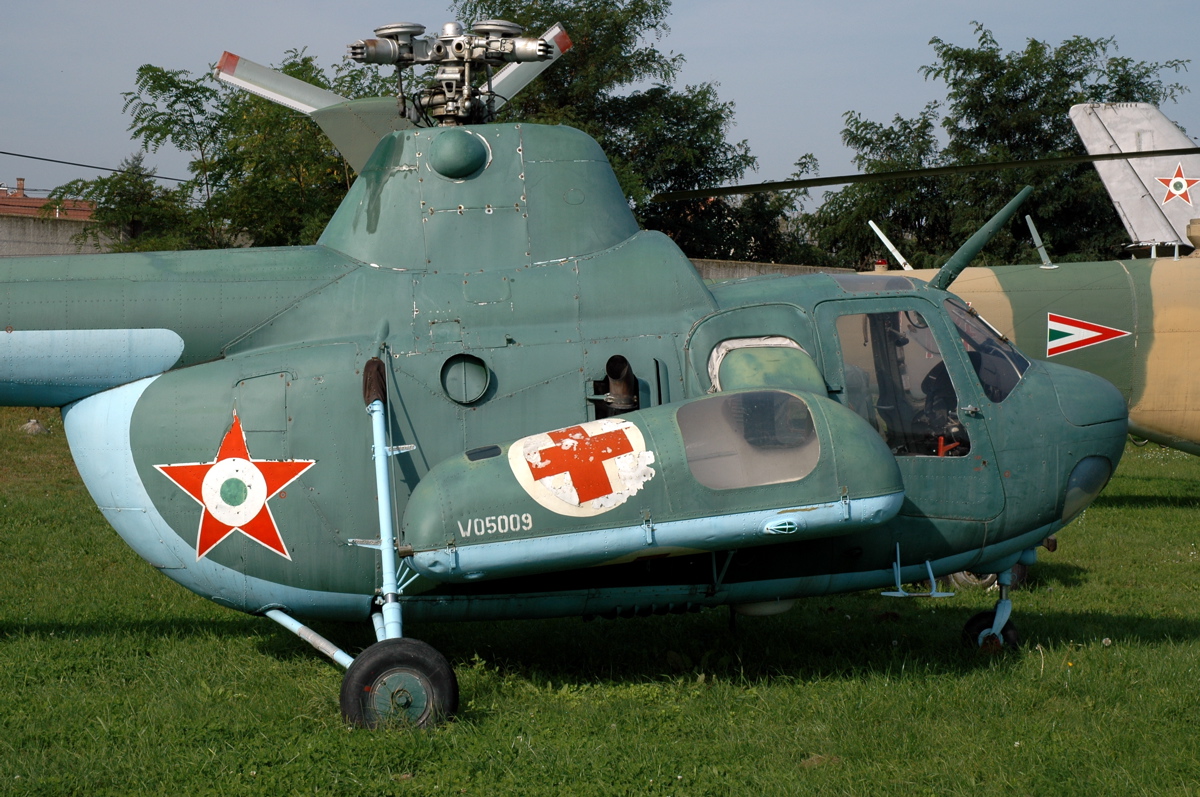
Here is a MedEvac version with stretcher sidecar but in Hungarian livery
In the front this time there were less progress and less action. It's interesting the air marshals are not attacking despite clear orders for aggresiveness. Ditto in Persia. Maybe you should embed NKVD MP brigades to HQs to keep the generals under constant pressure
Yes, and if that doesn't work, he might like a little field trip to Siberia...If so, he may be getting a displeased visitor from STAVKA soon to find out why he refused to attack an outnumbered enemy.
Interesting, how did I never notice this. It doesn't really make sense, especially if you look at the historical use of early night-fighting equipment. The first night vision apparatuses were too heavy and bulky to be used by infantry, they were mounted on tanks and other vehicles, it should almost be the other way around... If you disregard that aspect of it, you could make an argument that fighting on the move with early night vision equipment is rather difficult, and thus it may not benefit mobile formations quite as much as it does slower moving ones, but then they could have just made the modifier lower lower for these formations. It's definitely hard to believe that Mobile, and especially armoured and mechanised formations, wouldn't be fitted with night vision kit and/or wouldn't derive any advantage from it... I'd love to find out the thinking process behind this one.The next day, night fighting equipment was introduced for infantry formations. But for some strange reason, it was not usable for motorised or mechanised infantry brigades, nor any armour-based formations. Still, it should be of some assistance for night attacks, once fully introduced.
You can find out the exact National Unity of a country without tagging, just go into the Diplomacy screen, select the country, and hover your mouse over it's green-red 'surrender' bar, there it will say something like: "Surrender progress is xx%, with yy% of VPs in enemy hands and an National Unity of zz%" I don't have the game open right now, but it's something like that.Their national unity was assessed to have decreased slightly from 72.3% to 70% by the end of the month [I tagged briefly to determine this, as the estimate of around 59% on the intel screen was pretty absurd].
Things remain largely at a stalemate, the tide has been stopped and more reinforcements are on there way. Soon it will start going your way, slowly at first, and then ever faster (if supplies follow), as the weight of numbers, air raids, and armour becomes too much for the Japanese forces to counter.
Thanks @diskoerekto for the delightful pictures of the Mi-1, it's really a cute and useful little machine. The Red Army can surely use loads of them, especially for medevac.
Next month played through, illustrated, now just need to write it up. First, some comment feedback.

 My scientists and designers are working up to the helo technology. STAVKA does indeed send an evaluation team to Persia and makes an interesting discovery ...
My scientists and designers are working up to the helo technology. STAVKA does indeed send an evaluation team to Persia and makes an interesting discovery ...



 Thanks for reminding me.
Thanks for reminding me. 
Thanks everyone for your support. Hope to get the next ep out in a day or so.
Could be. I normally find them sailing to and from the east to west coasts or around the Atlantic (even though the Axis in Europe has been liquidated for months now).The US fleet might be sitting in a size 1 port, never being able to supply or repair.
Yes, roughly even that month. We’ll soon see if that changes at all in November.The entire front is all much of a muchness. Loss of an Adelaide here, saving a Melbourne there.
Nice pics!
Mi-1 looks nice isn't it?

Here is a MedEvac version with stretcher sidecar but in Hungarian livery
In the front this time there were less progress and less action. It's interesting the air marshals are not attacking despite clear orders for aggresiveness. Ditto in Persia. Maybe you should embed NKVD MP brigades to HQs to keep the generals under constant pressure
Indeed. Well, the bit that Japan hasn’t occupied.Yes, and if that doesn't work, he might like a little field trip to Siberia...
There should at least, as an alternative, be some separate night fighting gear for armoured and mech/mot formations, but there doesn’t seem to be anyInteresting, how did I never notice this. It doesn't really make sense, especially if you look at the historical use of early night-fighting equipment. The first night vision apparatuses were too heavy and bulky to be used by infantry, they were mounted on tanks and other vehicles, it should almost be the other way around... If you disregard that aspect of it, you could make an argument that fighting on the move with early night vision equipment is rather difficult, and thus it may not benefit mobile formations quite as much as it does slower moving ones, but then they could have just made the modifier lower lower for these formations. It's definitely hard to believe that Mobile, and especially armoured and mechanised formations, wouldn't be fitted with night vision kit and/or wouldn't derive any advantage from it... I'd love to find out the thinking process behind this one.
Of course <facepalm emoji>. I’ve used it many a time but just forgot about it on this occasion.You can find out the exact National Unity of a country without tagging, just go into the Diplomacy screen, select the country, and hover your mouse over it's green-red 'surrender' bar, there it will say something like: "Surrender progress is xx%, with yy% of VPs in enemy hands and an National Unity of zz%" I don't have the game open right now, but it's something like that.
This seems an accurate assessment - will see what November brings. Relying on the AI to gain and maintain the initiative is certainly something one needs to be patient with.Things remain largely at a stalemate, the tide has been stopped and more reinforcements are on there way. Soon it will start going your way, slowly at first, and then ever faster (if supplies follow), as the weight of numbers, air raids, and armour becomes too much for the Japanese forces to counter.
Yes, still a little way off being able to research helicopters and thus medevac, but getting there.Thanks @diskoerekto for the delightful pictures of the Mi-1, it's really a cute and useful little machine. The Red Army can surely use loads of them, especially for medevac.
Thanks everyone for your support. Hope to get the next ep out in a day or so.
Last edited:
Chapter 9 – November 1944
Chapter 9 – November 1944
AuthAAR’s Notes: The game once again played without a hitch. And I learned more about the vagaries of AI combat management.
There were no battles or skirmishes to report in the far Northern sector in November, with 6th Army firming up its positions and the Japanese not willing to attack. No territory exchanged hands there. The Central sector once again saw the most combat in the Far East, but it was generally less intense than in recent months, with the Soviets doing most of the attacking as the month wore on.
As the month began, fighting in Sinyuga continued from 24 October, where two Japanese infantry divisions were attacking 8 Tank Div (medium tanks). That battle finished in a Soviet victory at 0400 hr on 1 November, with over 800 Soviet and 1,500 Japanese soldiers falling.
The Japanese renewed their attack on Sinyuga at 2200 hr that night, with a fresh infantry division attacking the newly arrived 123 SD; 8 Tank Div was spent and was forced to withdraw as soon as the new attack began. The skirmish was over in five hours after the Japanese withdrew, with only light casualties on each side.
The next major action started at 0100 hr on 5 November, with two Soviet rifle divisions attacking a Manchurian infantry division (and assorted HQs) in the mountains of Mogoca. This battle would last for another ten days before the Soviets emerged victorious, killing 1,465 enemy soldiers for 577 Soviet heroes lost.
An attack at 1200 hr on 11 November by 21 Tank Div (medium) on a Manchurian militia division defending Novaya Chara was successful by 1700 hr on 14 November, with heavy Manchurian casualties, compared to light Soviet losses.
But a follow-up Soviet attack by 123 SD on the Japanese 53rd Hoheishidan (their earlier adversaries in Sinyuga) on Kedrovyy at 1900 hr on 14 November met with sterner resistance, when their assault was ambushed. The Soviets were forced to withdraw three days later, with moderately heavy casualties suffered by both sides.
As 100 and 324 SDs continued their advance on Mogoca (where they had won on 15 November), at 0400 hr on 25 November they encountered an already damaged [around 40% organisation] Manchurian militia division attempting a delaying defence. The Soviet commander MAJGEN Ponedelin launched a shock attack on the ill-prepared Manchurian militiamen, whose tactics were completely disrupted. This second (and smaller) battle of Mogoca was over by 2100 hr the following day, the Manchurians brushed aside with only light Soviet casualties.
By the end of the month, Sorgo had been reoccupied (earlier in the month, after a Soviet victory there in October), Novaya Chara was secured and Soviet forces were still advancing on the mountainous Mogoca. There were no battles in progress as midnight approached on 30 November. No air sorties had been performed by either side in the Northern or Central sectors during the month.
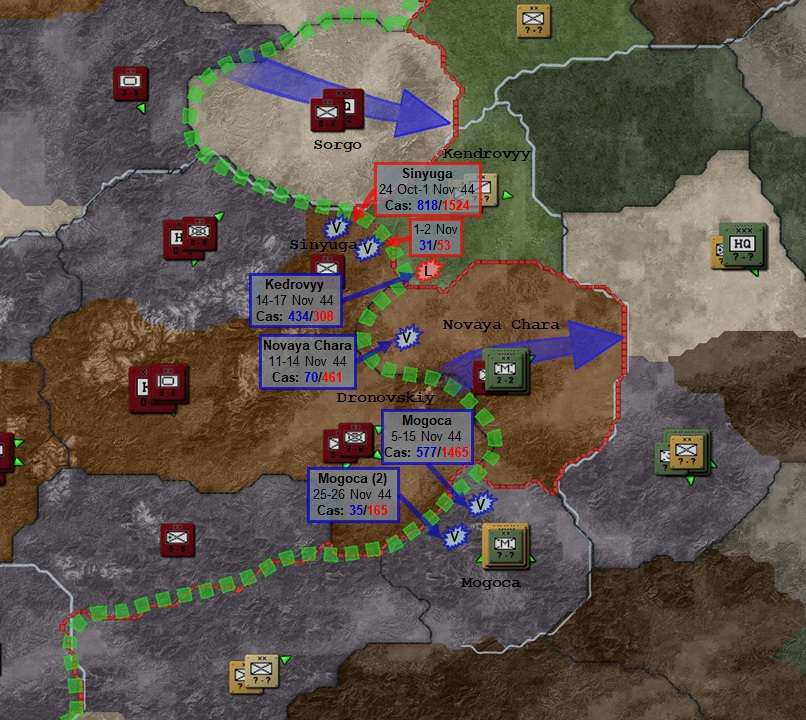
Operational summary, Soviet Far East – Central Sector, November 1944.
2. Far East Land Combat - Southern Sector
Early in November, the Japanese had started an attack on Mongolian troops defending Ider, north-east of Uliastay. No Soviet ground forces were involved, but Irkutsk-based Soviet aircraft launched a series of ground attacks in support of their allies on the Japanese forces attacking from Taryacin.
This triggered a dogfight on the early morning of 3 November, when a Japanese fighter wing (based out of Ulaanbataar, where it must have recently relocated) attempted to intercept the attacking Soviet aircraft. But they never even got to engage the Soviet bomber escorts: with commendable enthusiasm and efficiency, two INT wings (44 and 47 IADs, flying Yak-3s) scrambled and intercepted the Japanese fighters over Muren. They savaged the Japanese, who were so badly damaged and demoralised that a rare ‘aerial victory’ was proclaimed by the Air Force Chief Yakov Alksnis. The enemy fighters didn’t attempt to intercept any more Soviet air missions for the rest of the month.
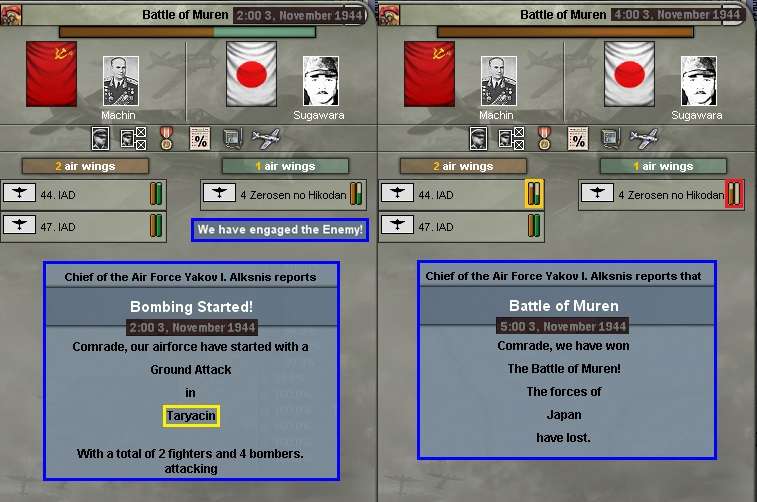
But despite over 800 attacking enemy troops being killed in these raids from 3-4 November, the Mongolians were forced to retreat on 4 November.
The Japanese followed up their victory in Ider ten days later with an ill-considered attack on Uliastay by one infantry division from Tarycin, at 1000 hr on 14 November. The provisional Mongolian capital was defended by the Soviet 2nd Guards Div and 187 SD, plus three Mongolian infantry divisions. There was another infantry division, and a garrison and militia division in reserve, while heavy Soviet air raids on Taryacin also disrupted the attackers. By the time the Japanese called off the attack three days later, they had lost over 1,100 men on the ground for about 200 Comintern casualties, while a further 1,500 were killed in Soviet air strikes.
In response to the earlier Japanese advance on Ider, on 15 November 1st Army was ordered to switch to an attacking stance, which 7th Army had been instructed to do – to little discernible effect – the month before. On 18 November, the Japanese occupied Ider and both 1st and 7th Armies (both of which had forces in the vicinity) were ordered to retake it. However neither had acted on this command by the end of the month.
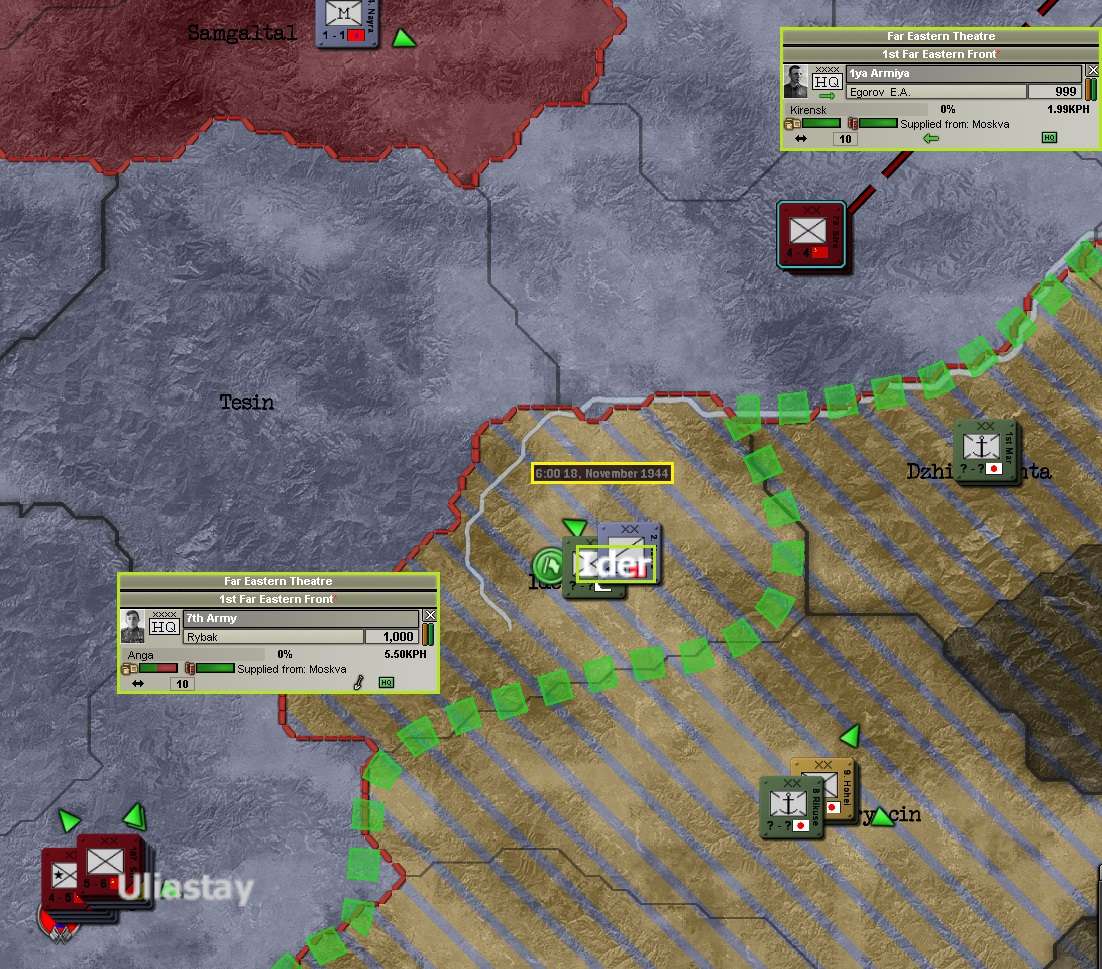
1st Army had by now prepared an impressive build-up of divisions in the sector north-east of Lake Baikal: twelve divisions in all were poised there by the evening of 25 November. 1st Army had refrained all month from attacking Burjatija or Bukacaca, but with orders to attack and plenty of air support in range, maybe a major offensive would commence soon [If nothing happens in early December, I might assign a couple of specific objectives for those two provinces to see if it might prod them into action.]
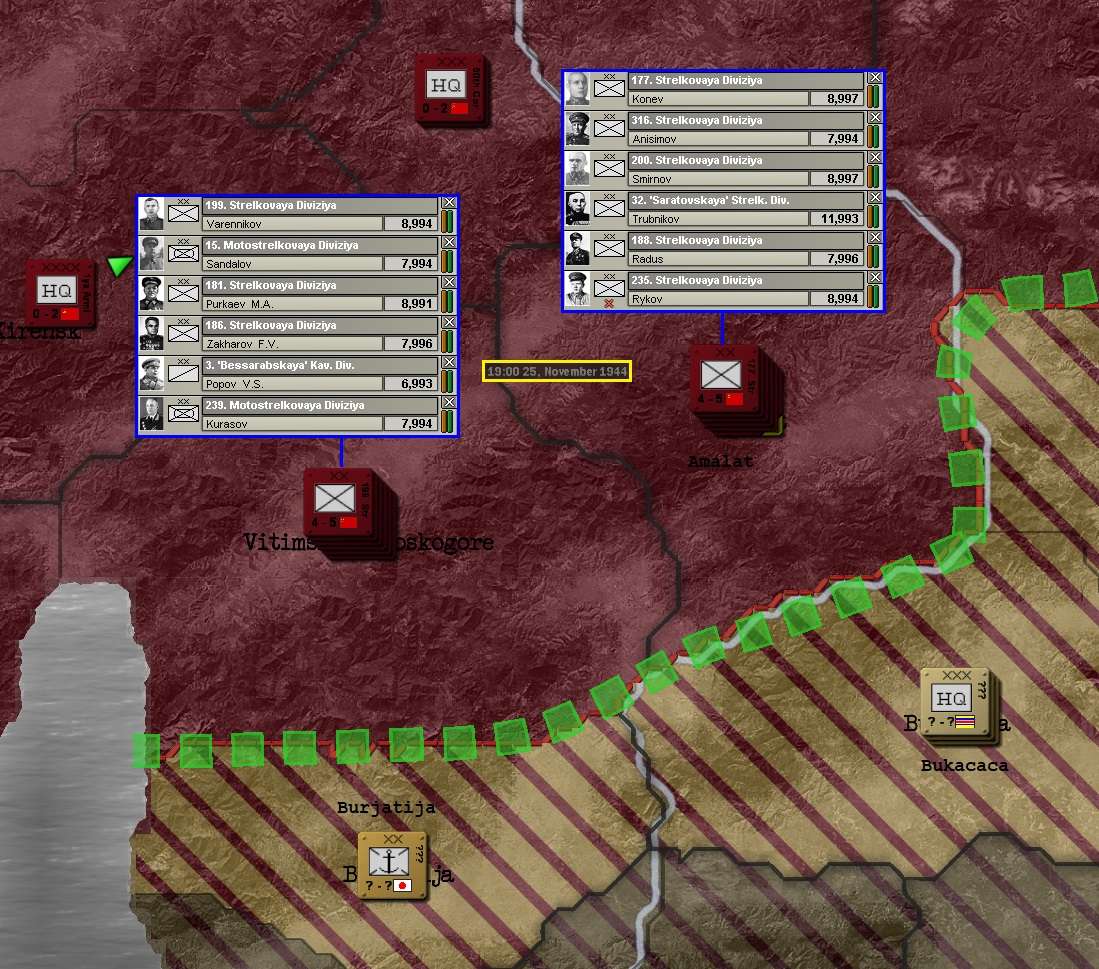
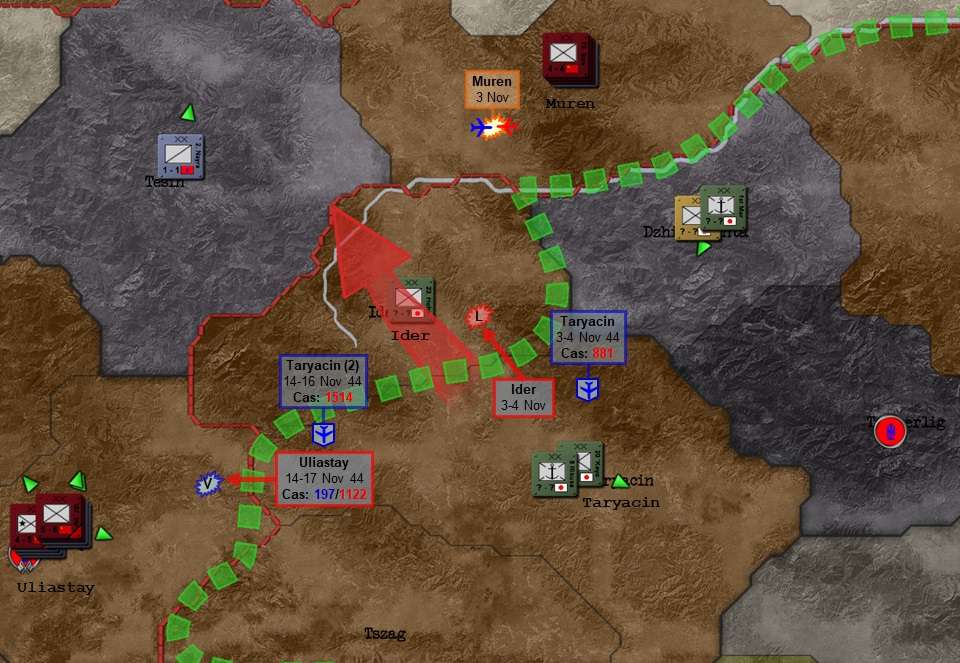
Operational summary, Soviet Far East – Southern Sector, November 1944.
3. Persia
After the Persian front again remained quiet in early November, a fact-finding mission was sent from STAVKA on 6 November to investigate. The mystery was solved: due to a mistake in the transmission of orders, the Western Front commander Marshal Magon had had all his Persian objectives cancelled. [Duh! No real idea how this happened – perhaps it resulted from a reorg or temporary detachment/reattachment of units the month before.] Too afraid to challenge what Magon thought must have been orders to hold in place, nothing had happened there for some weeks.
No real idea how this happened – perhaps it resulted from a reorg or temporary detachment/reattachment of units the month before.] Too afraid to challenge what Magon thought must have been orders to hold in place, nothing had happened there for some weeks.
No-one from Magon upwards to STAVKA itself could be sure who was to blame and, afraid any attempt to assign such might rebound on the accusers, the whole debacle was simply brushed under the carpet. New orders were soon reissued to conquer all key Persian centres.

The troops were all eager enough and an attack on the Persian 1st Cavalry Division defending Ardabil began just two hours after the new orders were issued! 1st Guards Div and 28 SD shocked the defenders with the aggression of their assault. They had won their victory by 0800 hr on 9 November.
By this time, both the western and eastern sectors were inspired by admirable revolutionary zeal (or fear of the NKVD) to resume the offensive, with broad advances on both fronts now well underway. The Persian Front had changed from ‘sleepy hollow’ to a hive of activity in just a few days.

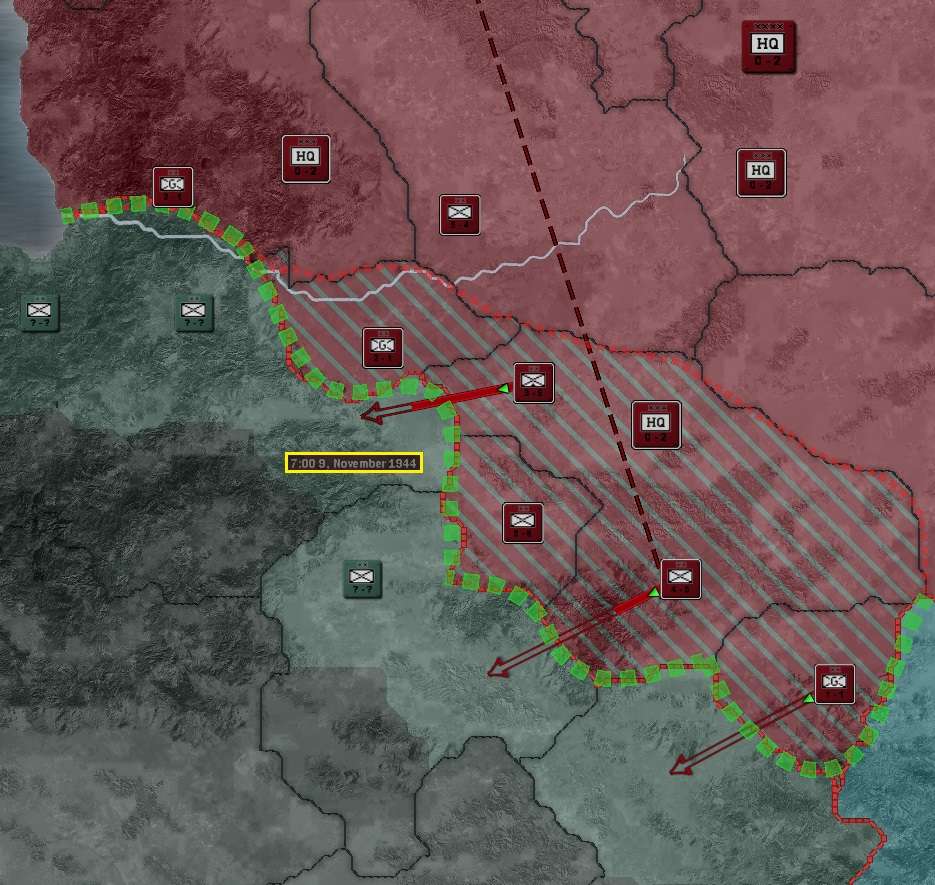
The battle of Diz Chah (western sector) began at 2200 hr on 10 November, as 69 Mtn Div and 325 SD closed with the Persian 5th Infantry. Victory came a day later after a short but sharp battle.
The major battle of the front for the month began in Gorgan, a hilly province in the north of the Western sector, at 0100 hr on 14 November. Two Soviet second-string garrison divisions took on the well-entrenched Persian 2nd Infantry – and the initial odds were tough for the Soviets.
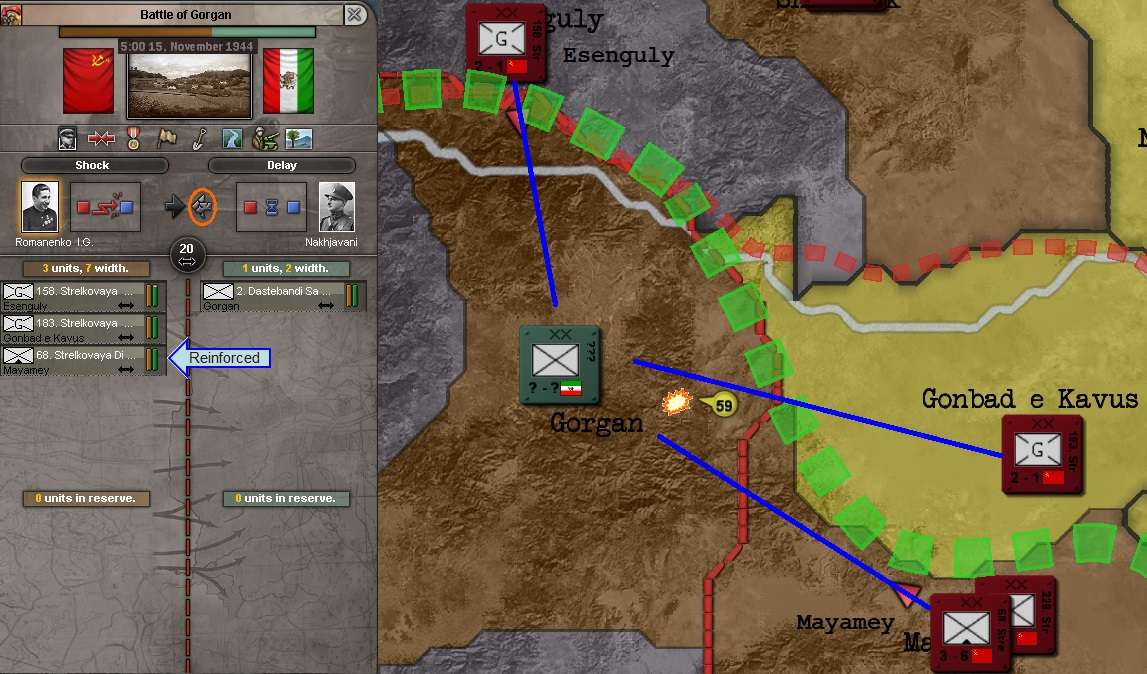
A little over a day later, the attackers were reinforced by 68 Mtn Div, attacking from a new flank in Mayamey. This flank attack shocked the defending Persians, who had been attempting to delay. And having regular specialist mountain troops involved also made a big difference. The tide of battle in Gorgan began to swing to the Soviets.
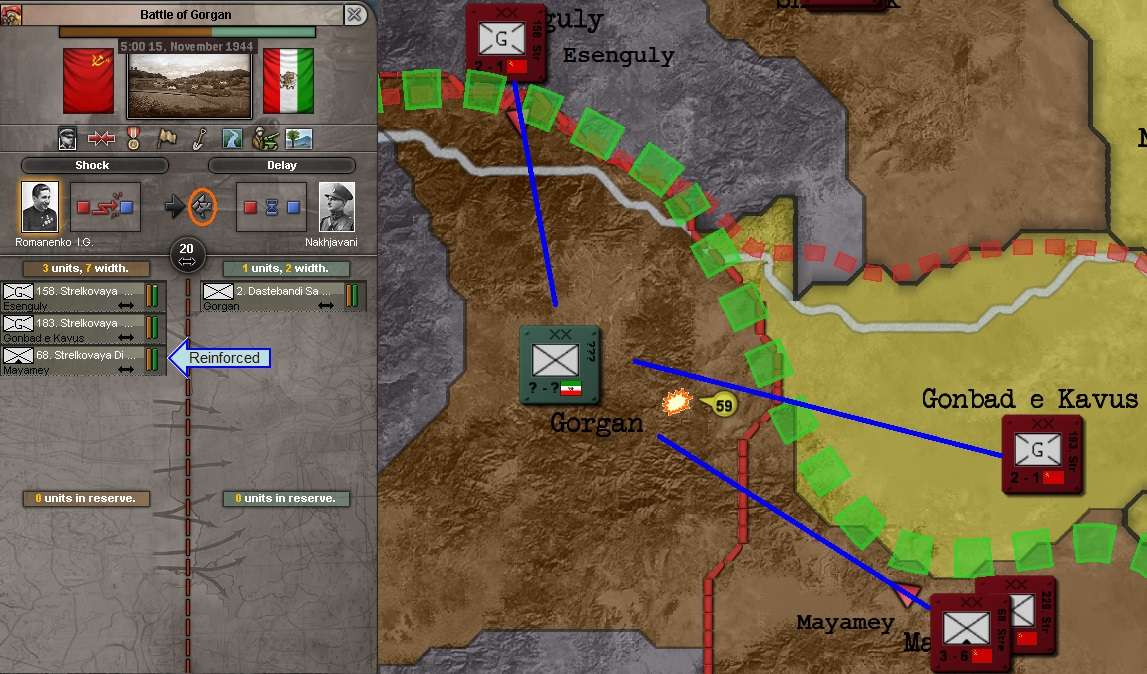
But it would take another four days of bitter fighting before the Soviets emerged victorious in Gorgan at 0300 hr on 19 November, both sides losing over a thousand men.
183 SD attacked the retreating Persian 1st Cavalry in Abhar – due west of Tehran – at 0500 hr on 20 November, encountering no resistance as the Persians kept retreating east to their capital. By then, good progress had been made in both the east and west.
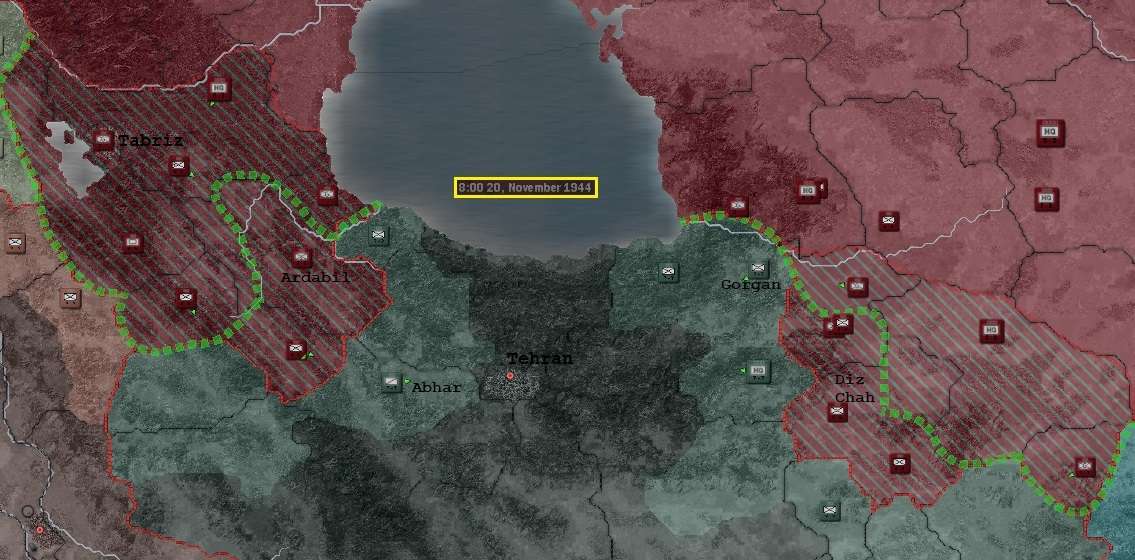
Skirmishes followed in the west as the Soviet advance continued, with the Persians being beaten in Robat e Khan (1100-1700 hr on 24 November) and Darband (1300-1500 hr on 30 November), while Soviet troops had occupied Abhar, on Tehran's doorstep.
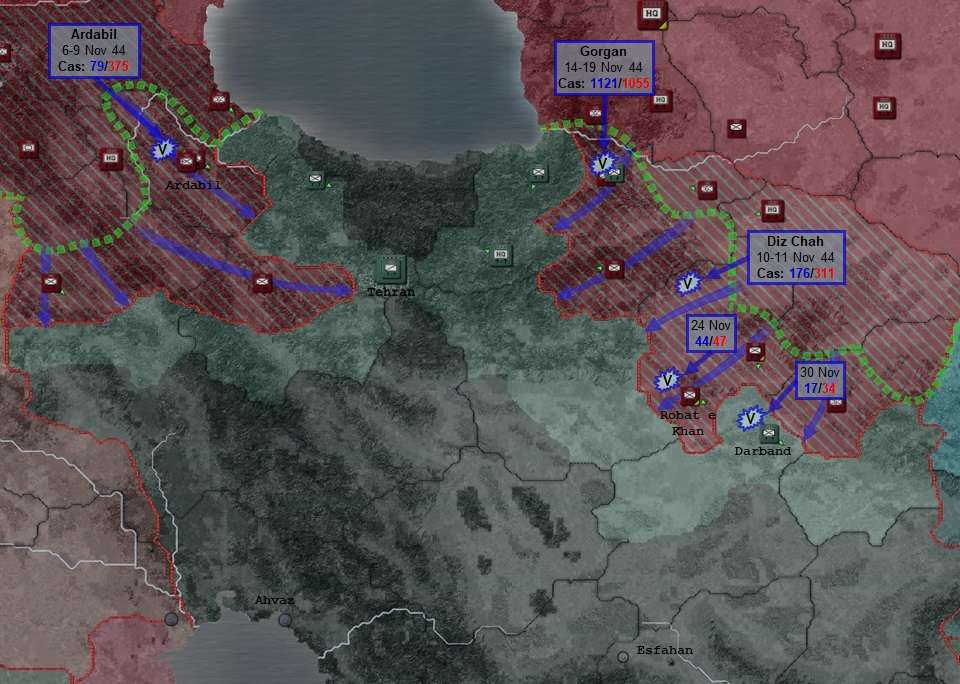
Operational summary, Persia, November 1944.
4. Naval Operations
A new transport flotilla was completed on 26 November and deployed to Admiral Kuznetsov’s Red Banner Pacific Fleet in Petropavlovsk Kamcackji. The first instalment of the forces which may one day embark on an invasion of the Japanese Home Islands.
Five Japanese convoys were sunk by Soviet submarines during the month, with no discernible opposition.
5. Diplomatic and Intelligence
2 November was a black day for the GRU in Manchukuo, with the locals arresting two Soviet spies at once, though they were soon replaced.
In the west, the Soviets finally got sick of the Hungarian and German aircraft occupying Soviet air bases near the border with the Allied nations. Though not before Soviet agents had provided a detailed report of the types and characteristics of the planes stationed there. [I had to tag over briefly to get rid of them, so took the opportunity for a close look, which I thought was only fair and quite reasonable.]
The Hungarian planes (CAS, TAC and INT) proved to be antiquated, pre-war crates. Nothing much to worry about there! They were sent back to their homeland with derisory gestures.

However, once the German aircraft were flushed out of their closely guarded hangars in Nowogródek, the sight was far more sobering. All had jet engines, with the TAC (Ar-234B Blitzes) sporting radar-guided missiles and bombs, and the CAS (Hs-132s) were also equipped with radar-guided missiles. The Multi-role fighters (Me 262s) looked very nasty too, though at least they weren’t yet equipped with air-air missiles.
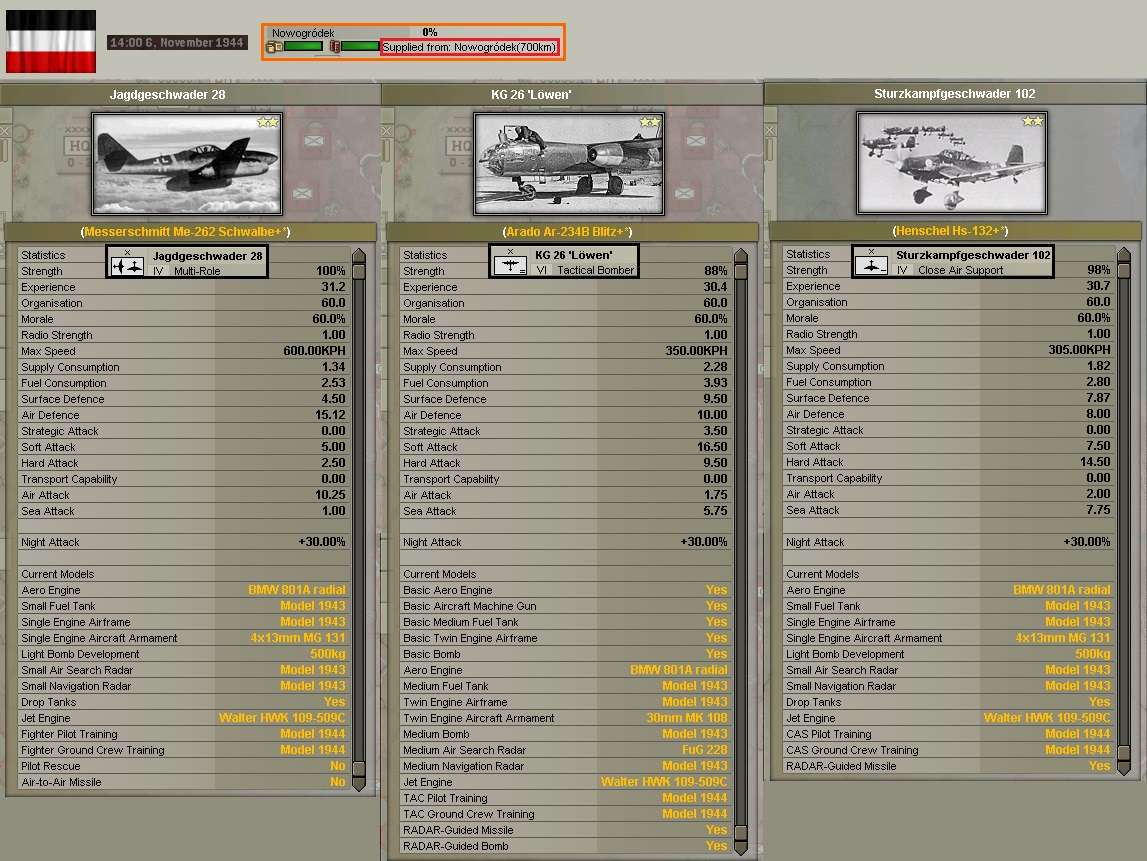
If this was the standard of equipment among the leading Allied powers, then the recent frenetic technical research in Soviet aircraft design, engines and rockets was shown to be vital to prepare for any future conflict.
[Game Question: for both these foreign air forces, their unit screens said they were being supplied from the location of their bases. Does this mean they may be getting supplies (if available) by air from their respective homelands? Or has the Soviet Union been supplying them all this time?]
NKVD Head Ivan Proskurov reported on 20 November that the Finnish resistance cell detected the month before in Kalliosami had been located and destroyed. He furnished a report on revolt risk in Finland, which was worst in the south-east, near the Soviet border. There was also a report on unrest in the patchwork areas of French-occupied Romania, where patriots agitated against foreign occupation (as opposed to the reactionary troublemakers in Finland). The wisdom of the Soviet Union ‘liberating’ those parts of Romania they had taken at the end of the war against the Axis in Europe was trumpeted.
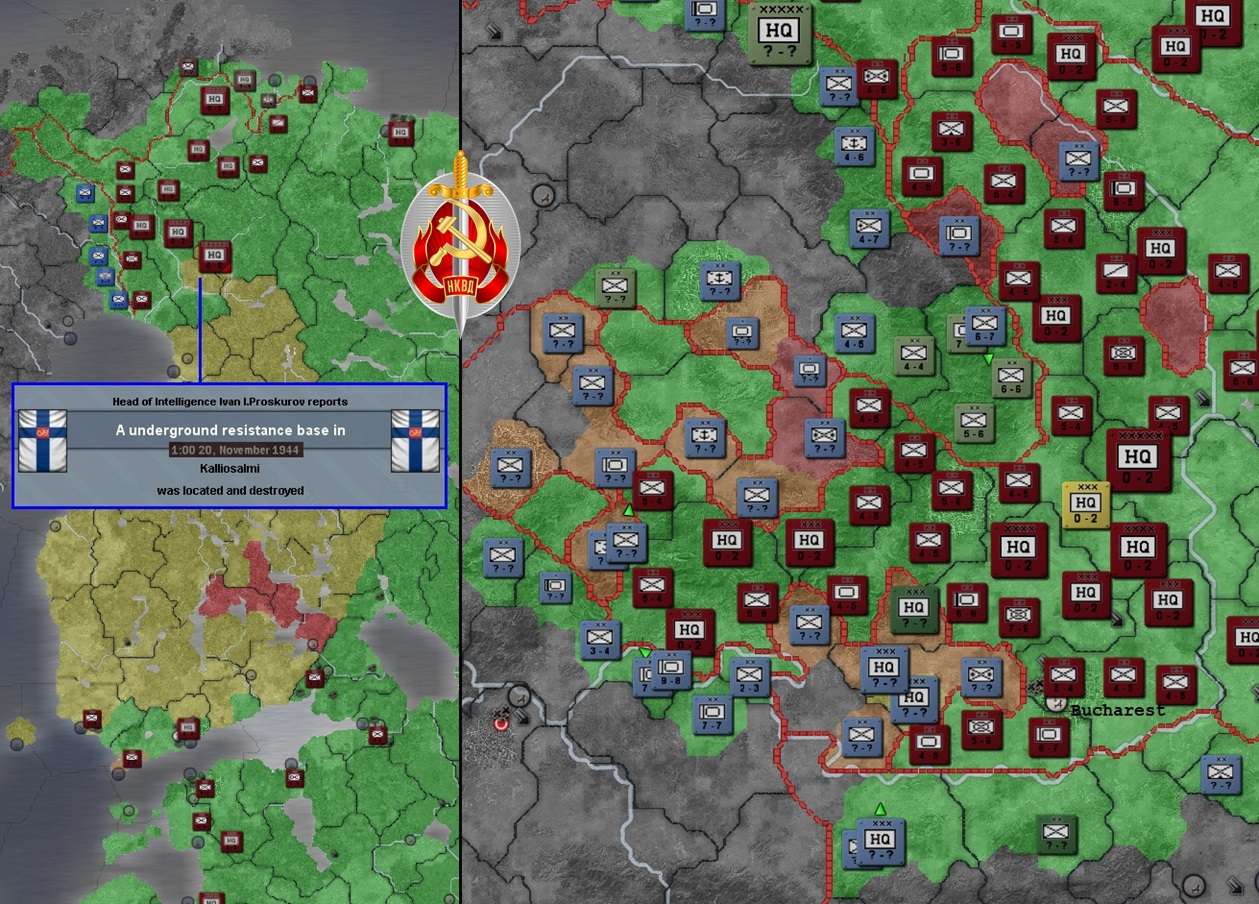
On 29 November, Molotov reported that the Tibetans had again started to align towards the Comintern. All were welcome, no matter how small or out of the way.
In Japan, the Kempeitai had started the month with no teams in the field. They added three during the month, but then all had been liquidated again by the end of it. No Soviet agents were lost there. Manchukuo had started with two agents and didn’t lose either of them, though they added none either. As mentioned previously, the Soviets lost two agents there early, but no more by the end of the month. Manchurian national unity was reduced marginally from 70% to 69.7% by the end of the month – the rate of decrease lessened due to a partial switch back to a counter-espionage focus in October.
The Soviets had lost the two teams in Manchukuo mentioned above, but had trained four more, so finished with a full 10-team presence at home, in Japan and in Manchukuo, and now had ten in reserve: up two in total from the end of October. This was approaching the point where a third overseas mission might be contemplated – perhaps to one of the major Allied nations (France, Britain, Germany or the US, all of which had been regularly sending spies to the Soviet Union). But more reserves would be needed for that. The usual diverse collection of foreign spies [14 according to the intel mouse-over] was also apprehended during the month in the Soviet Union.
6. Research
It was a fruitful month for Soviet researchers, with seven advances made in a range of fields. The main (though not exclusive) focus of new projects was on improving the air force.
Supply production was improved (and was now well in hand again), while more fighter airframe research could eventually also lead to helicopter development.
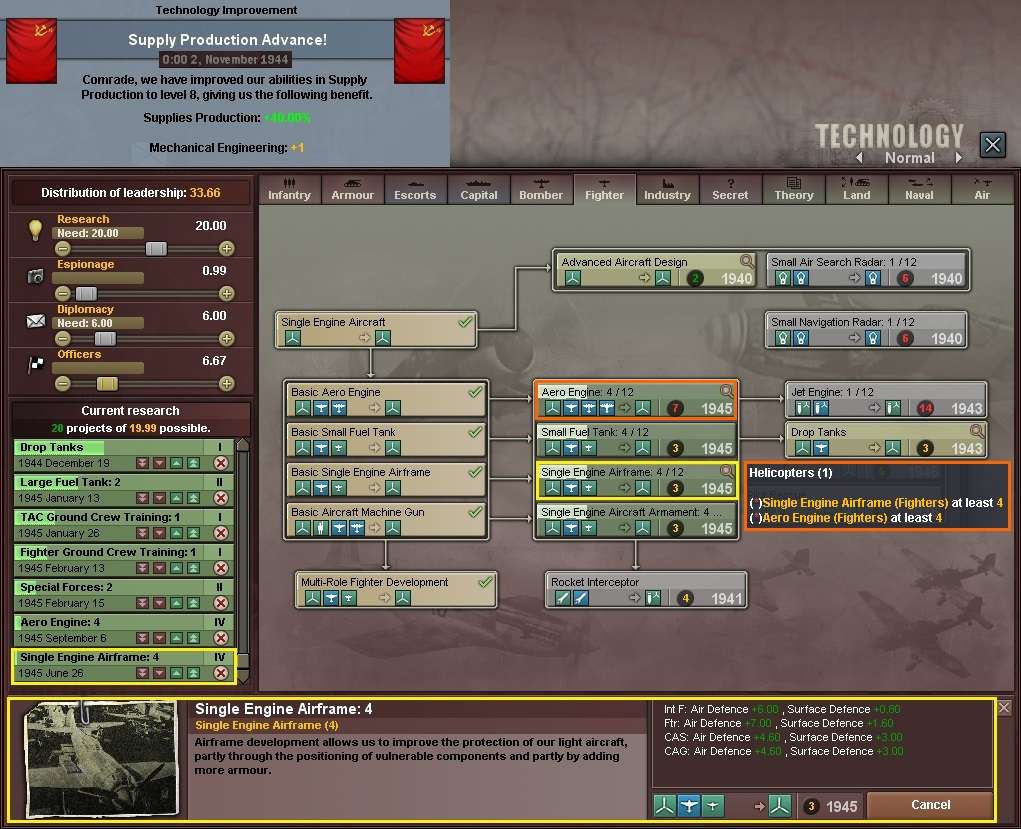
Superior firepower doctrine will permit five-brigade divisions to be establish – while would gradually be phased in later, as new brigades could be produced (no mass-amalgamations were contemplated). Schwerpunkt doctrine – learned from the Germans in earlier fighting – was the next to be researched.
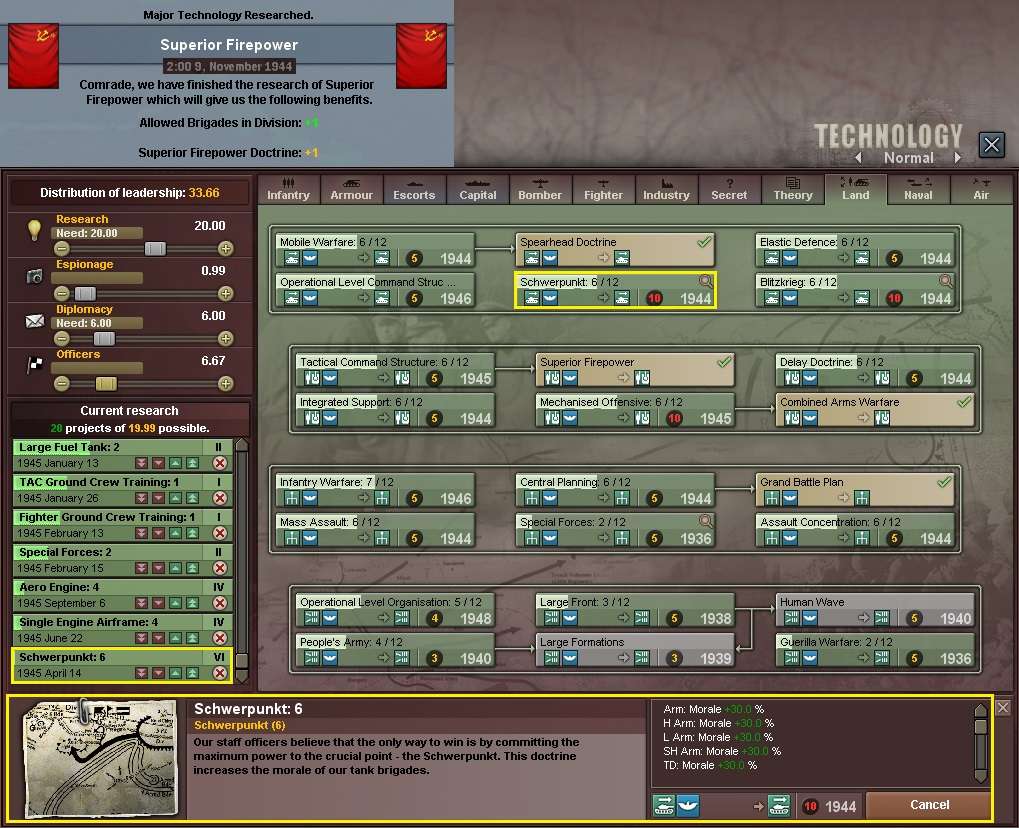
With industrial production methods improved, attention was turned to developing better fighter interception tactics.
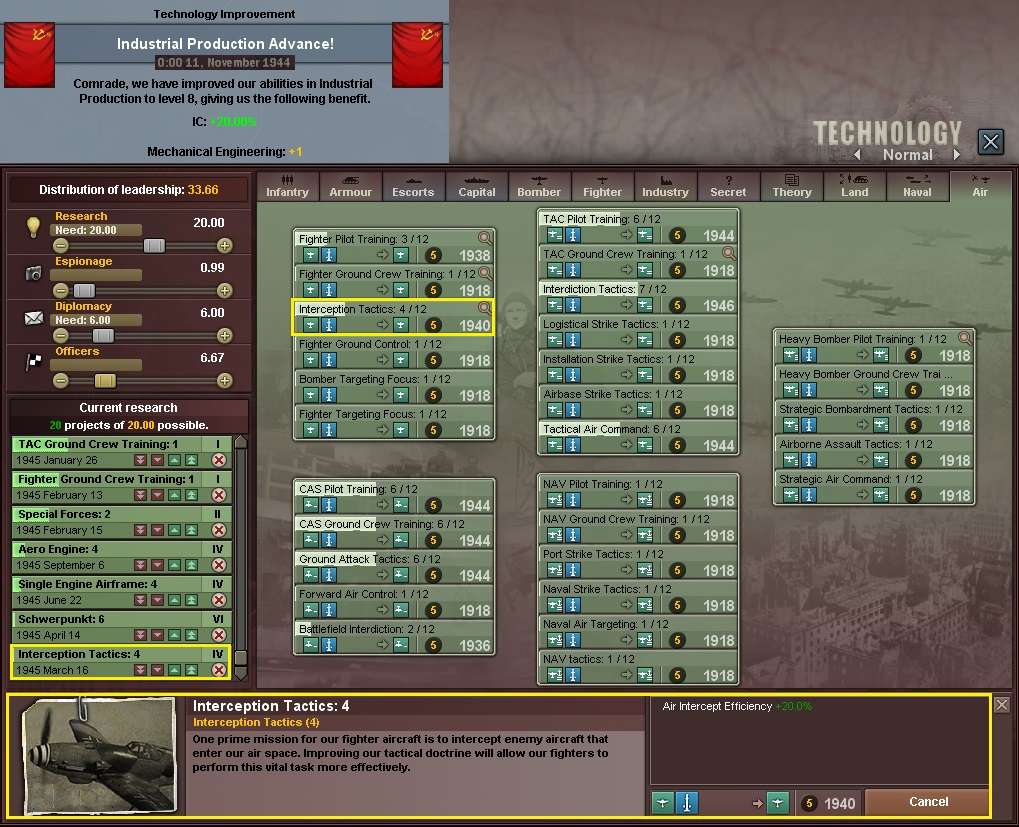
Top secret nuclear physics research reached the next level on 17 November and those scientists were kept at it – at an undisclosed location, of course!
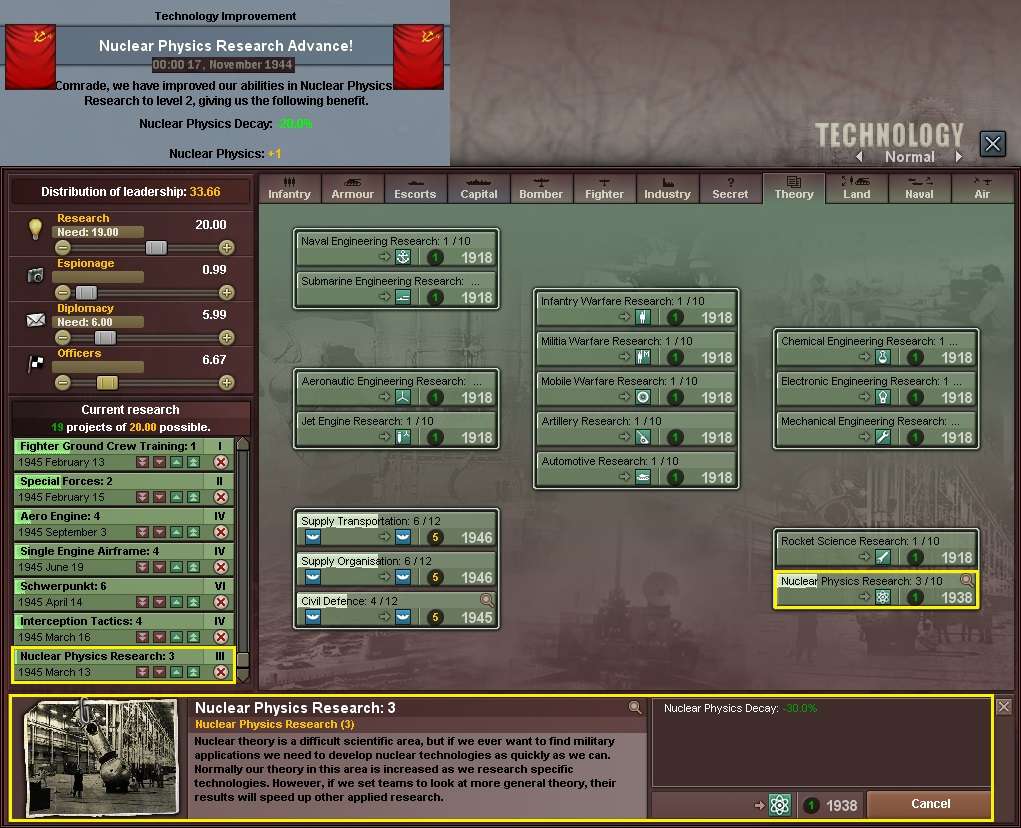
Advanced aircraft design capabilities allowed the development of airborne radar for Soviet aircraft – something which the leading Allied air forces had as a matter of course by then. A small air search radar would be the first to be developed – and should be a welcome improvement for detection and night fighting.

Next came the development of a marine infantry capability, which was rolled straight into the development of amphibious warfare equipment for them. Marines would start being trained in due course.
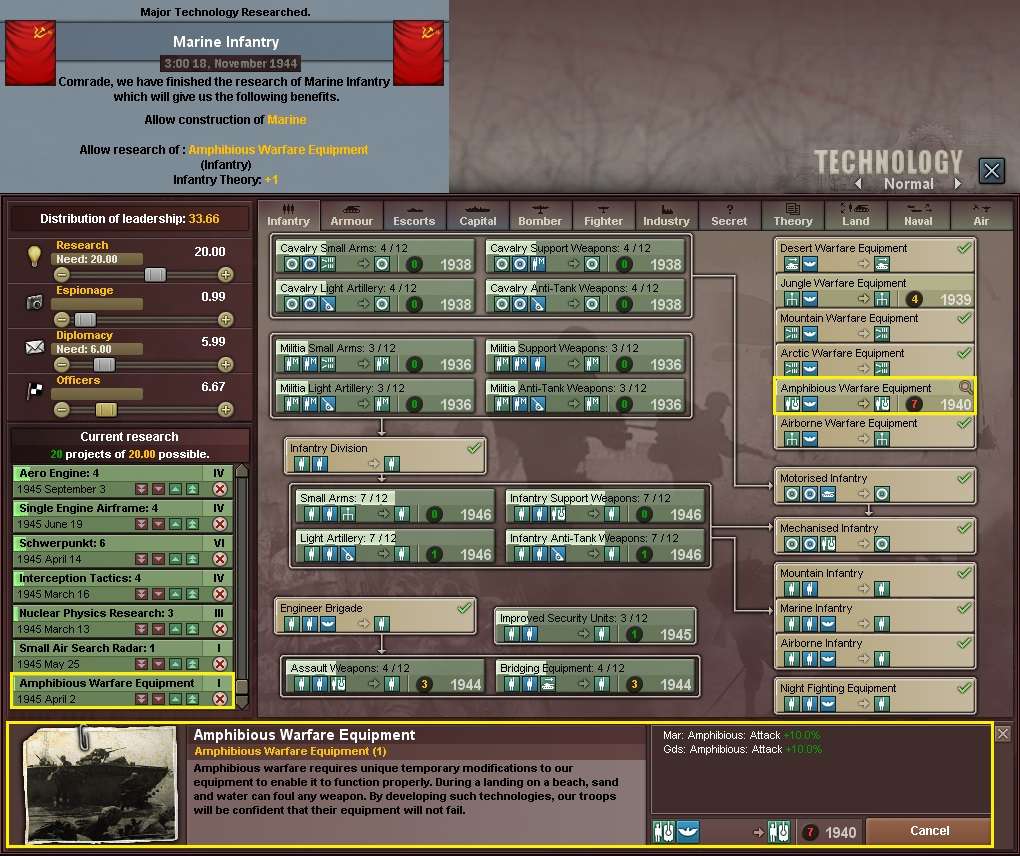
And on 29 November heavy bomber pilot training received its first improvement: the doctrine team was kept on the same task, given they were starting from such a low base.
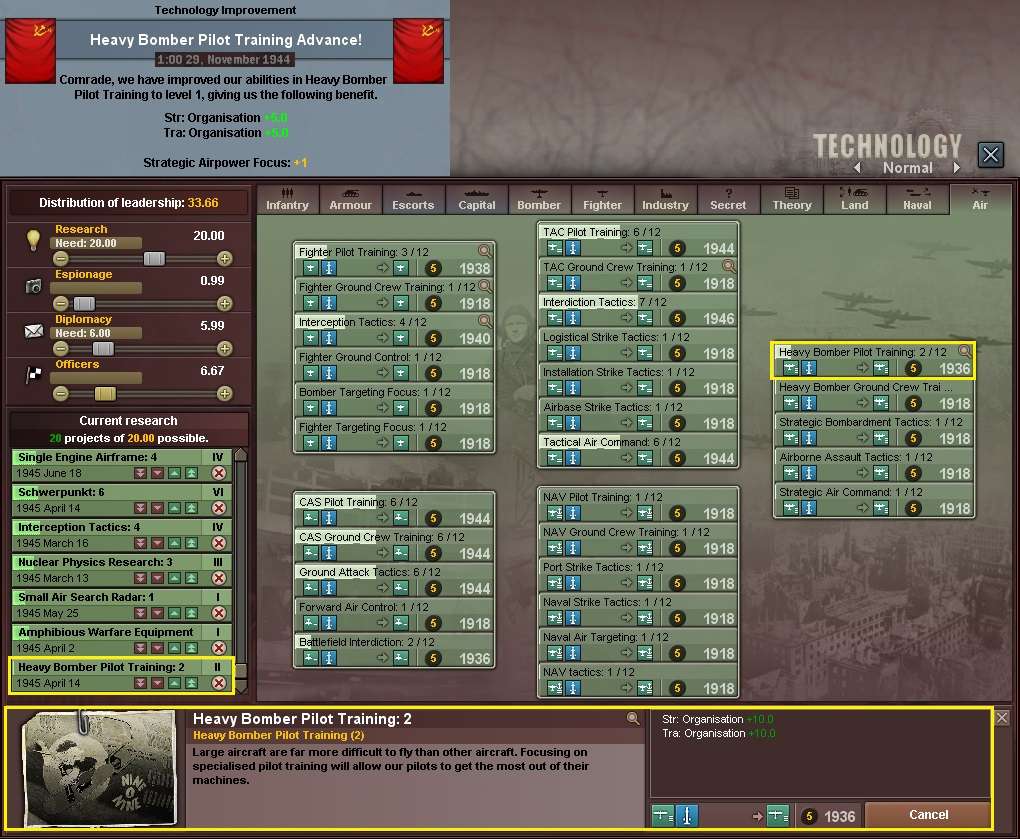
******
7. Production
It was also a busy month for Soviet industry, with upgrade and supply demands lowering significantly and a number of projects being completed. First was a new INT wing, which was sent to Irkutsk on 9 November. It had been so long in production that it deployed with obsolete LaGG-3s and had to go through an immediate upgrade program.
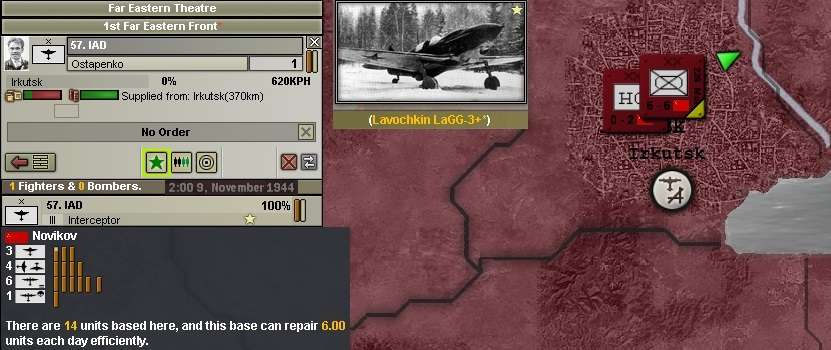
Another new fighter wing became available on 17 November, but was sent to Kaunas on the German border instead, as the Far East was assessed as having more than enough already. They too were old LaGG-3s. By that time, the production queue was almost all at full efficiency, with even the new battleship Sovyetskiy Soyuz at the bottom of the list resuming construction after being left idle for months. Supply production was down to under 40IC per day.
A first improvement to the Olenek air base on 18 November was followed up immediately with work on level three facilities.
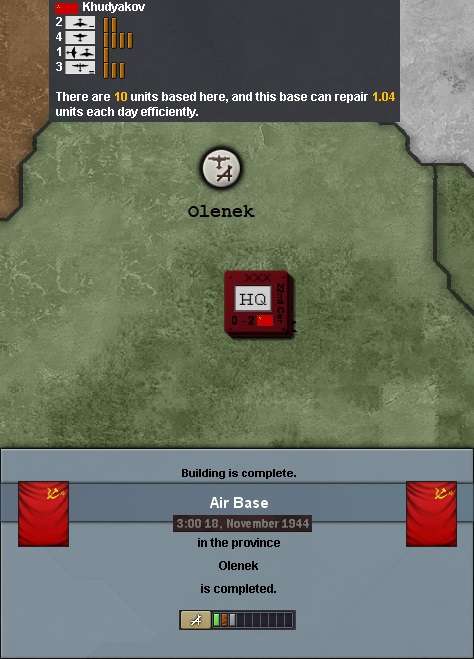
And by 19 November, there was enough capacity to commission new land units once again: four infantry brigades were put in training, to begin the gradual top-up of divisions to five brigade strength.
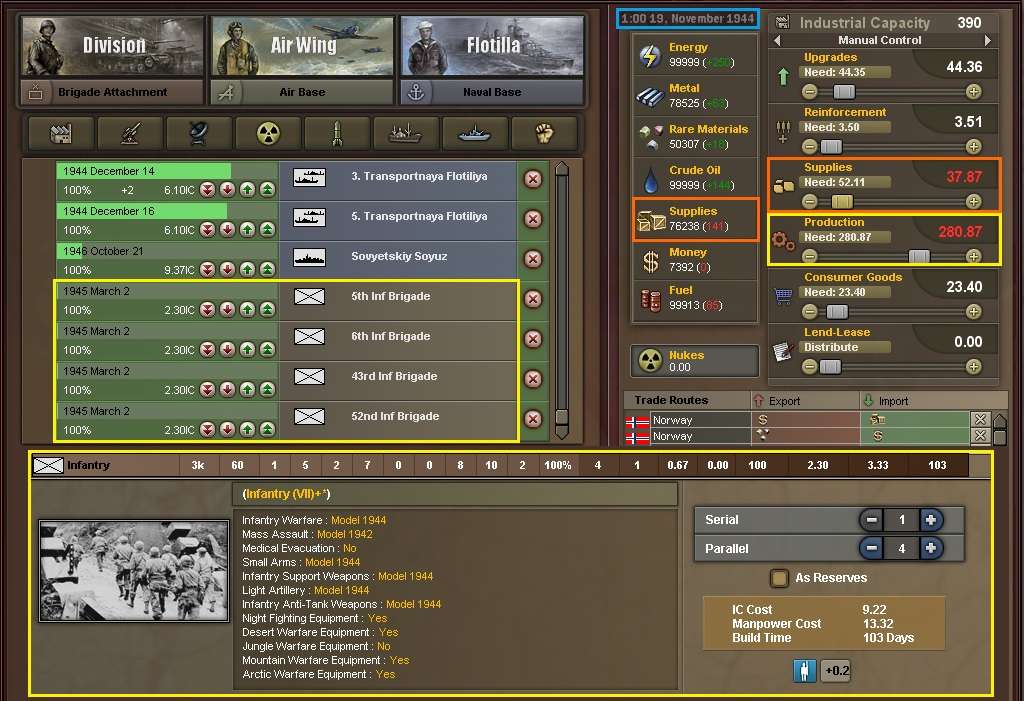
Another new INT wing was deployed to Kaunas on 21 November. This freed capacity for the construction of three new radar stations and a couple more infantry brigades.
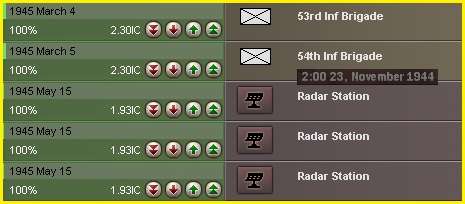
Another infantry brigade was squeezed into the queue on 26 November. Then on 28 November, a red-letter (how appropriate  ) day for Soviet aircraft manufacturing: the first strategic bomber wing was set into production. It was time to start getting some practical production experience. And there was enough capacity to fully fund it, if the supply stockpile was allowed to run down for a while.
) day for Soviet aircraft manufacturing: the first strategic bomber wing was set into production. It was time to start getting some practical production experience. And there was enough capacity to fully fund it, if the supply stockpile was allowed to run down for a while.

******
8. Global Summaries
The Far East had seen some limited exchange of ground: some hard-won gains in the Central sector, with the Mongolians losing Ider in the south.
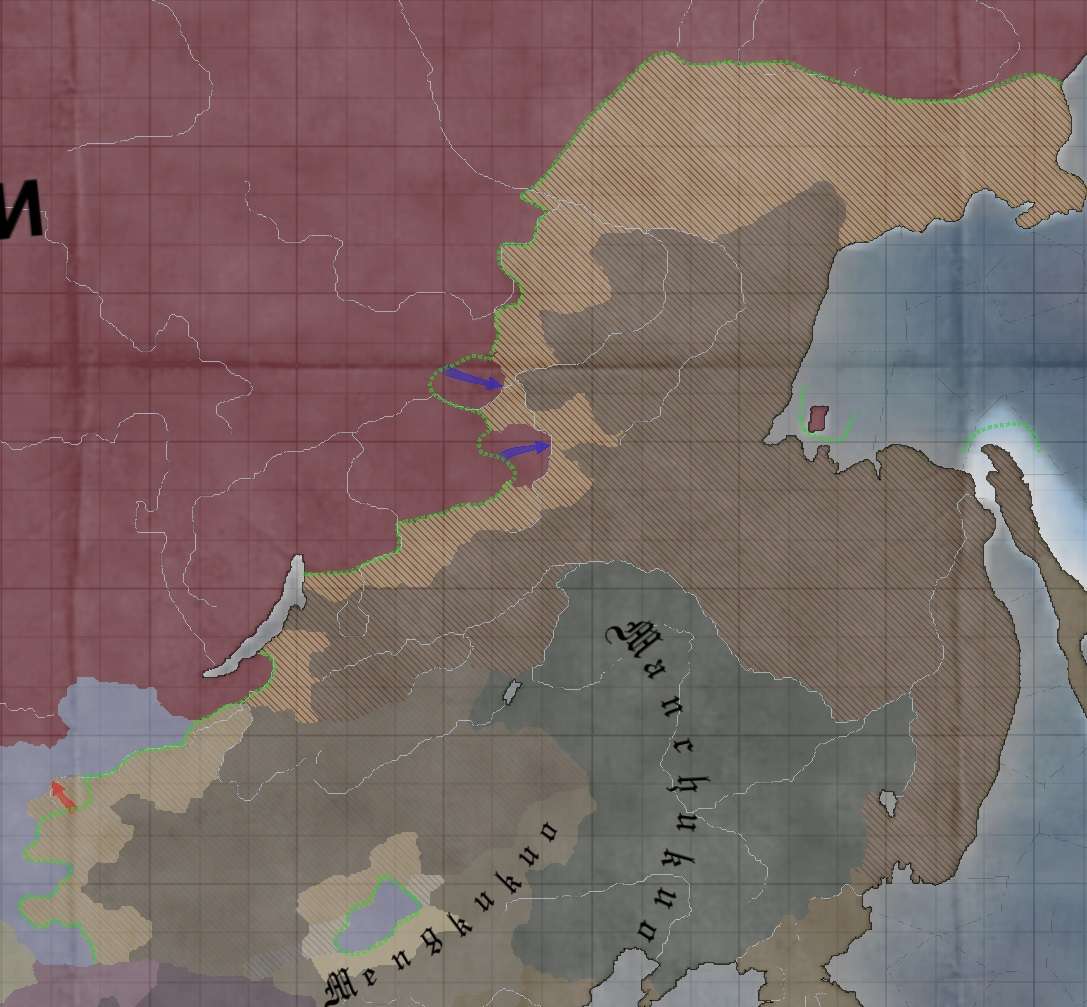
Total recorded losses to land combat for battles were less than in previous months, even with increased activity in Persia. The Soviets were lost 3,599 men against 6,922 Axis soldiers killed in both theatres. There were again no Soviet losses from air raids, with 2,395 Axis soldiers killed in from air strikes – all on Taryacin. Total combat losses for the USSR were therefore 3,599, with the Axis losing 9,313.
South East Asia again showed mixed results for the Allies.

They had again lost ground in Indo-China – which continued not to worry the Soviets much, so long as the front didn’t collapse and kept drawing top-line Japanese marine divisions into the fight.
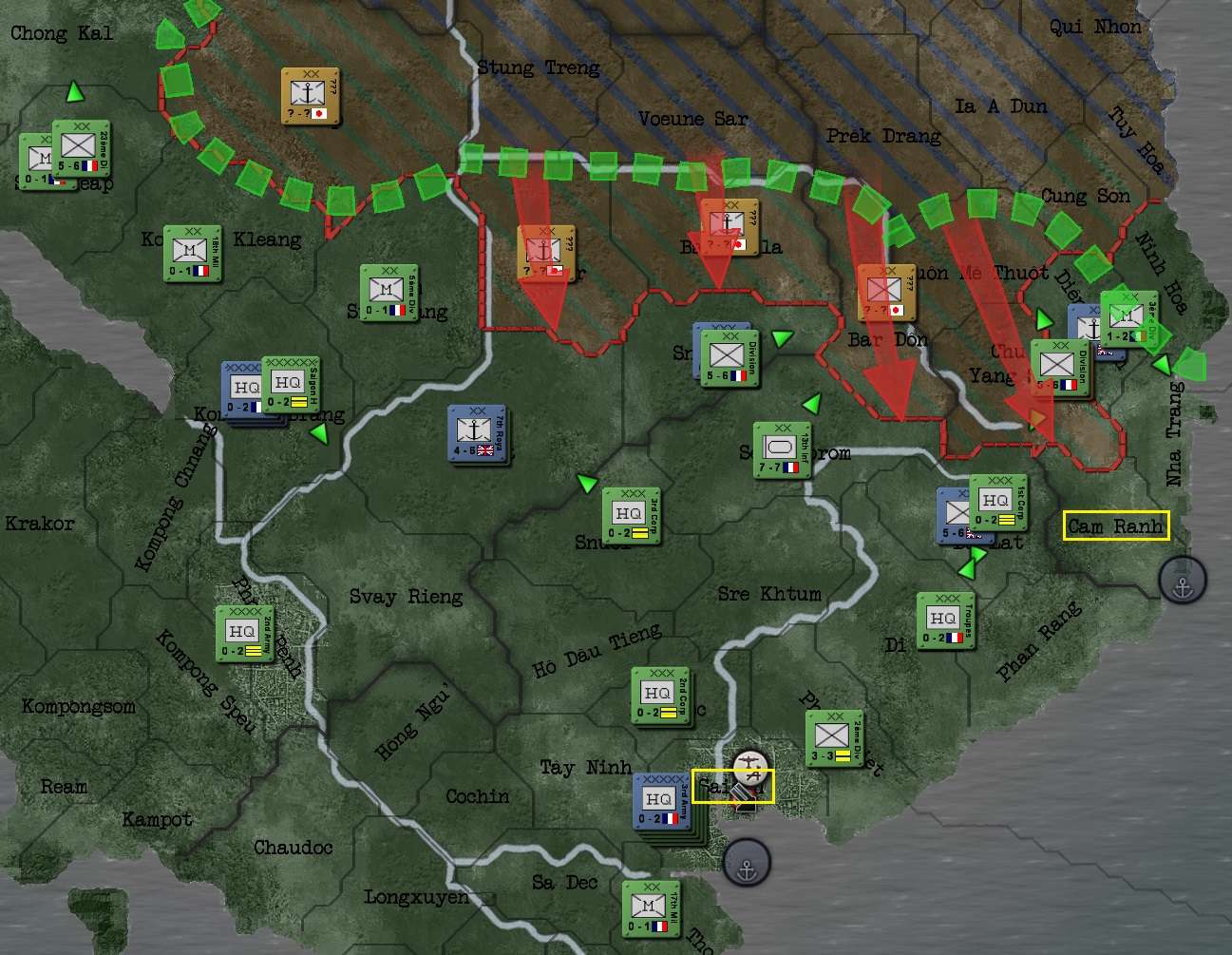
The Allies (Anglo-French units) had finally broken out in Malaya, liberating Kuala Lumpur and threatening Japan’s hold on the great naval and resources base of Singapore.
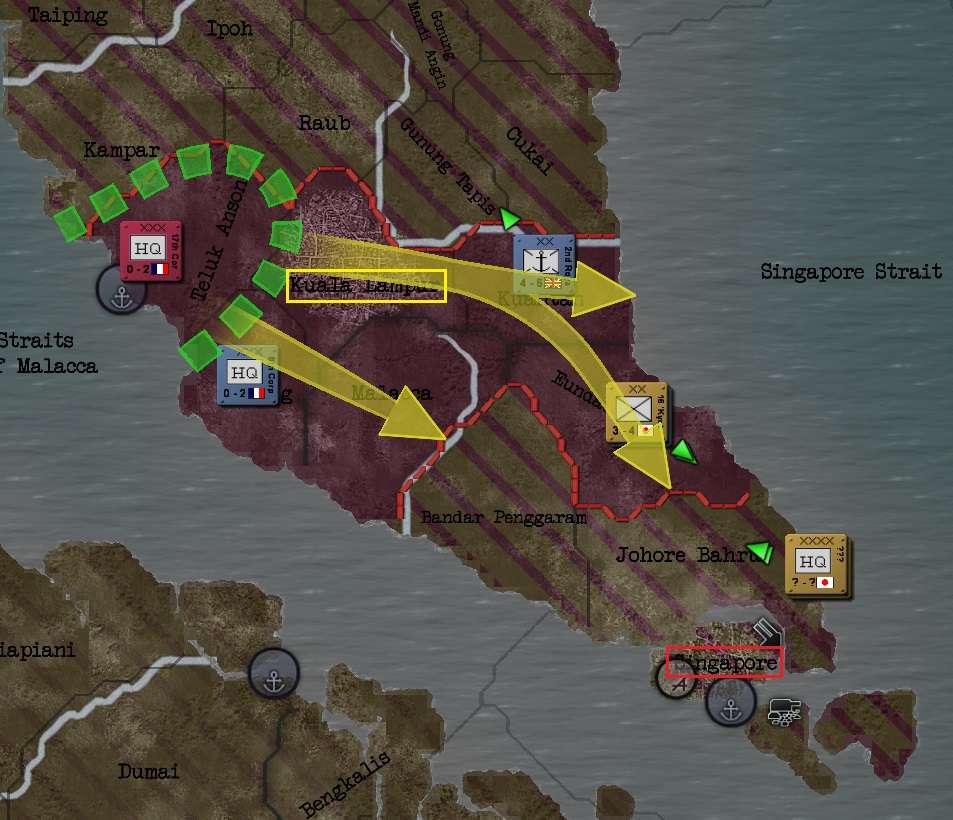
And the Dutch had recovered most of their lost territory in Java and seemed to be attacking the last isolated (and perhaps unsupplied) Japanese marine division west of Djogjakarta.
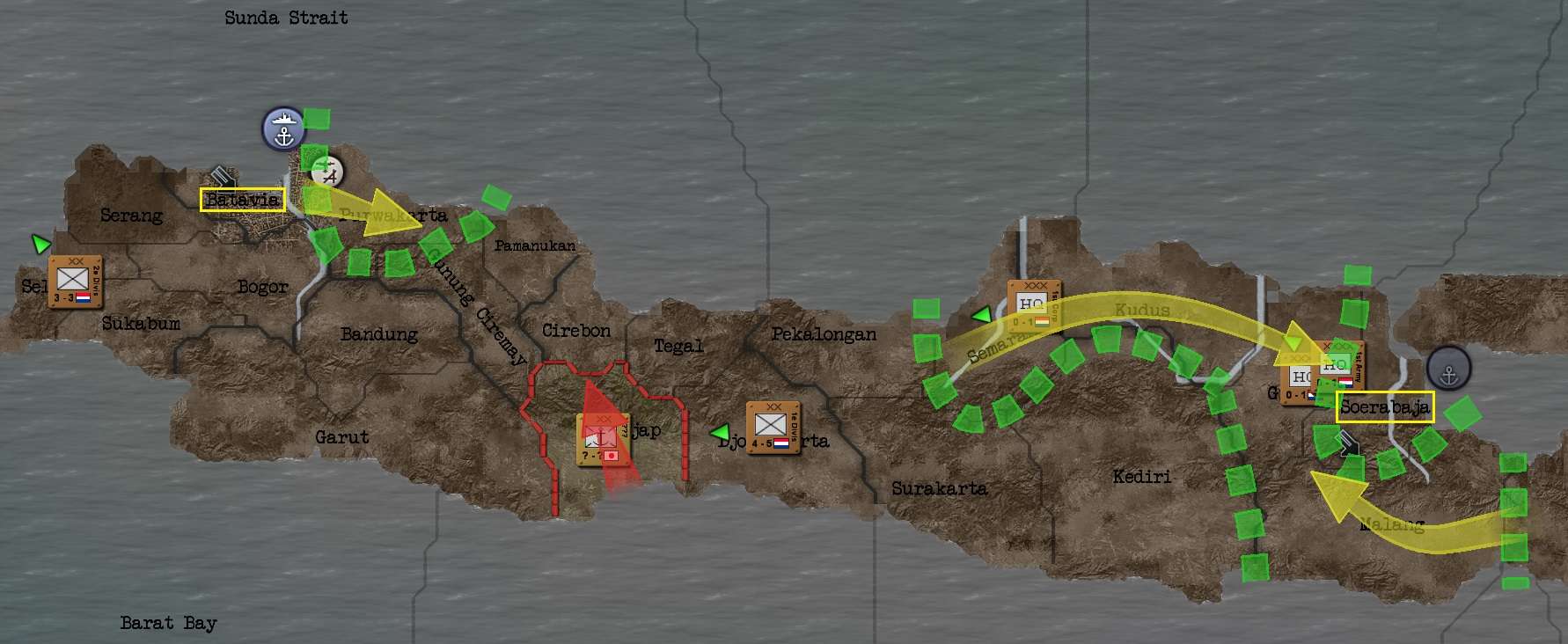
Guerrillas had liberated some territory in eastern Sumatra, but little else had changed there. And other than an isolated partisan uprising in Mindanao, nothing else had changed in the rest of South East Asia.
In Australia, the Allies were finally pushing back to the north in Queensland, where new divisions seemed to have been landed during the month. But they had lost some ground in Victoria, around Melbourne.
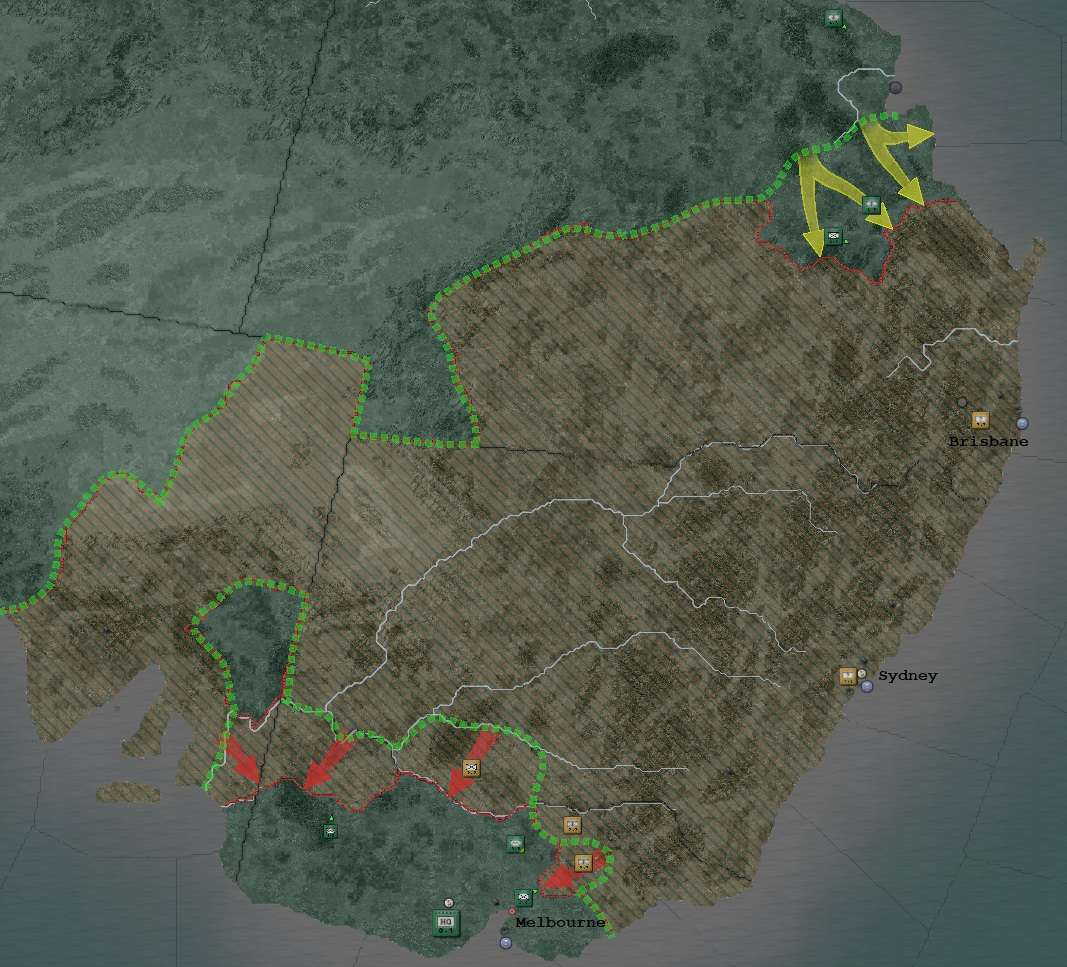
British and American forces under Australian command were beginning to roll through undefended land along the Pacific coast and hinterland towards distant Brisbane.

And although some recently won ground had been lost again, the Australians and their Allies still seemed to be holding onto Melbourne, where they had counter-attacked towards the north-east.
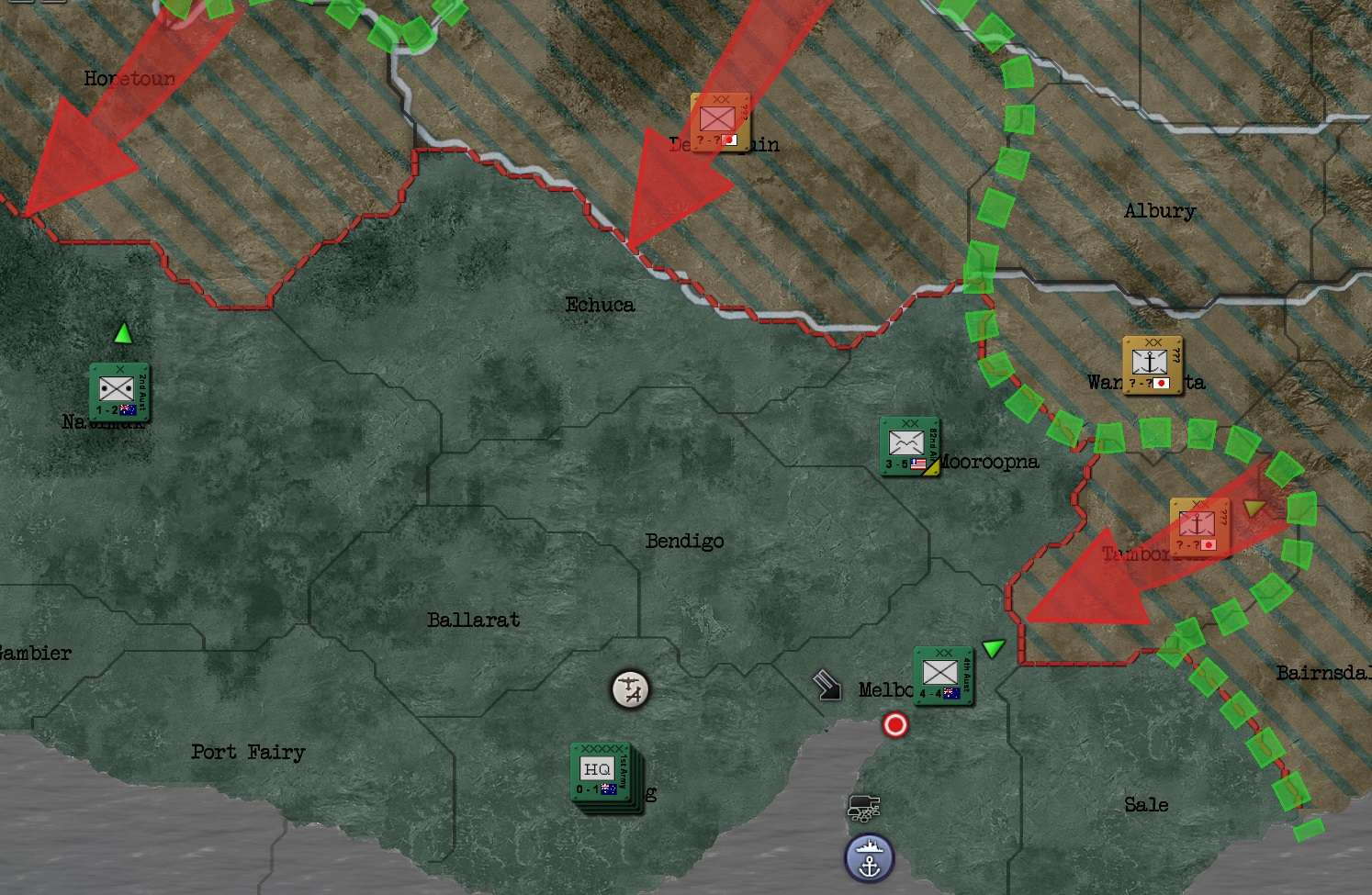
As usual, there were no observed changes or major actions in the Central Pacific.
AuthAAR’s Notes: The game once again played without a hitch. And I learned more about the vagaries of AI combat management.
******
1. Far East Land Combat - Central Sector
There were no battles or skirmishes to report in the far Northern sector in November, with 6th Army firming up its positions and the Japanese not willing to attack. No territory exchanged hands there. The Central sector once again saw the most combat in the Far East, but it was generally less intense than in recent months, with the Soviets doing most of the attacking as the month wore on.
As the month began, fighting in Sinyuga continued from 24 October, where two Japanese infantry divisions were attacking 8 Tank Div (medium tanks). That battle finished in a Soviet victory at 0400 hr on 1 November, with over 800 Soviet and 1,500 Japanese soldiers falling.
The Japanese renewed their attack on Sinyuga at 2200 hr that night, with a fresh infantry division attacking the newly arrived 123 SD; 8 Tank Div was spent and was forced to withdraw as soon as the new attack began. The skirmish was over in five hours after the Japanese withdrew, with only light casualties on each side.
The next major action started at 0100 hr on 5 November, with two Soviet rifle divisions attacking a Manchurian infantry division (and assorted HQs) in the mountains of Mogoca. This battle would last for another ten days before the Soviets emerged victorious, killing 1,465 enemy soldiers for 577 Soviet heroes lost.
An attack at 1200 hr on 11 November by 21 Tank Div (medium) on a Manchurian militia division defending Novaya Chara was successful by 1700 hr on 14 November, with heavy Manchurian casualties, compared to light Soviet losses.
But a follow-up Soviet attack by 123 SD on the Japanese 53rd Hoheishidan (their earlier adversaries in Sinyuga) on Kedrovyy at 1900 hr on 14 November met with sterner resistance, when their assault was ambushed. The Soviets were forced to withdraw three days later, with moderately heavy casualties suffered by both sides.
As 100 and 324 SDs continued their advance on Mogoca (where they had won on 15 November), at 0400 hr on 25 November they encountered an already damaged [around 40% organisation] Manchurian militia division attempting a delaying defence. The Soviet commander MAJGEN Ponedelin launched a shock attack on the ill-prepared Manchurian militiamen, whose tactics were completely disrupted. This second (and smaller) battle of Mogoca was over by 2100 hr the following day, the Manchurians brushed aside with only light Soviet casualties.
By the end of the month, Sorgo had been reoccupied (earlier in the month, after a Soviet victory there in October), Novaya Chara was secured and Soviet forces were still advancing on the mountainous Mogoca. There were no battles in progress as midnight approached on 30 November. No air sorties had been performed by either side in the Northern or Central sectors during the month.

Operational summary, Soviet Far East – Central Sector, November 1944.
******
2. Far East Land Combat - Southern Sector
Early in November, the Japanese had started an attack on Mongolian troops defending Ider, north-east of Uliastay. No Soviet ground forces were involved, but Irkutsk-based Soviet aircraft launched a series of ground attacks in support of their allies on the Japanese forces attacking from Taryacin.
This triggered a dogfight on the early morning of 3 November, when a Japanese fighter wing (based out of Ulaanbataar, where it must have recently relocated) attempted to intercept the attacking Soviet aircraft. But they never even got to engage the Soviet bomber escorts: with commendable enthusiasm and efficiency, two INT wings (44 and 47 IADs, flying Yak-3s) scrambled and intercepted the Japanese fighters over Muren. They savaged the Japanese, who were so badly damaged and demoralised that a rare ‘aerial victory’ was proclaimed by the Air Force Chief Yakov Alksnis. The enemy fighters didn’t attempt to intercept any more Soviet air missions for the rest of the month.

The Japanese followed up their victory in Ider ten days later with an ill-considered attack on Uliastay by one infantry division from Tarycin, at 1000 hr on 14 November. The provisional Mongolian capital was defended by the Soviet 2nd Guards Div and 187 SD, plus three Mongolian infantry divisions. There was another infantry division, and a garrison and militia division in reserve, while heavy Soviet air raids on Taryacin also disrupted the attackers. By the time the Japanese called off the attack three days later, they had lost over 1,100 men on the ground for about 200 Comintern casualties, while a further 1,500 were killed in Soviet air strikes.
In response to the earlier Japanese advance on Ider, on 15 November 1st Army was ordered to switch to an attacking stance, which 7th Army had been instructed to do – to little discernible effect – the month before. On 18 November, the Japanese occupied Ider and both 1st and 7th Armies (both of which had forces in the vicinity) were ordered to retake it. However neither had acted on this command by the end of the month.



Operational summary, Soviet Far East – Southern Sector, November 1944.
******
3. Persia
After the Persian front again remained quiet in early November, a fact-finding mission was sent from STAVKA on 6 November to investigate. The mystery was solved: due to a mistake in the transmission of orders, the Western Front commander Marshal Magon had had all his Persian objectives cancelled. [Duh!
No-one from Magon upwards to STAVKA itself could be sure who was to blame and, afraid any attempt to assign such might rebound on the accusers, the whole debacle was simply brushed under the carpet. New orders were soon reissued to conquer all key Persian centres.

By this time, both the western and eastern sectors were inspired by admirable revolutionary zeal (or fear of the NKVD) to resume the offensive, with broad advances on both fronts now well underway. The Persian Front had changed from ‘sleepy hollow’ to a hive of activity in just a few days.


The major battle of the front for the month began in Gorgan, a hilly province in the north of the Western sector, at 0100 hr on 14 November. Two Soviet second-string garrison divisions took on the well-entrenched Persian 2nd Infantry – and the initial odds were tough for the Soviets.


183 SD attacked the retreating Persian 1st Cavalry in Abhar – due west of Tehran – at 0500 hr on 20 November, encountering no resistance as the Persians kept retreating east to their capital. By then, good progress had been made in both the east and west.


Operational summary, Persia, November 1944.
******
4. Naval Operations
A new transport flotilla was completed on 26 November and deployed to Admiral Kuznetsov’s Red Banner Pacific Fleet in Petropavlovsk Kamcackji. The first instalment of the forces which may one day embark on an invasion of the Japanese Home Islands.
Five Japanese convoys were sunk by Soviet submarines during the month, with no discernible opposition.
******
5. Diplomatic and Intelligence
2 November was a black day for the GRU in Manchukuo, with the locals arresting two Soviet spies at once, though they were soon replaced.
In the west, the Soviets finally got sick of the Hungarian and German aircraft occupying Soviet air bases near the border with the Allied nations. Though not before Soviet agents had provided a detailed report of the types and characteristics of the planes stationed there. [I had to tag over briefly to get rid of them, so took the opportunity for a close look, which I thought was only fair and quite reasonable.]
The Hungarian planes (CAS, TAC and INT) proved to be antiquated, pre-war crates. Nothing much to worry about there! They were sent back to their homeland with derisory gestures.


[Game Question: for both these foreign air forces, their unit screens said they were being supplied from the location of their bases. Does this mean they may be getting supplies (if available) by air from their respective homelands? Or has the Soviet Union been supplying them all this time?]
NKVD Head Ivan Proskurov reported on 20 November that the Finnish resistance cell detected the month before in Kalliosami had been located and destroyed. He furnished a report on revolt risk in Finland, which was worst in the south-east, near the Soviet border. There was also a report on unrest in the patchwork areas of French-occupied Romania, where patriots agitated against foreign occupation (as opposed to the reactionary troublemakers in Finland). The wisdom of the Soviet Union ‘liberating’ those parts of Romania they had taken at the end of the war against the Axis in Europe was trumpeted.

In Japan, the Kempeitai had started the month with no teams in the field. They added three during the month, but then all had been liquidated again by the end of it. No Soviet agents were lost there. Manchukuo had started with two agents and didn’t lose either of them, though they added none either. As mentioned previously, the Soviets lost two agents there early, but no more by the end of the month. Manchurian national unity was reduced marginally from 70% to 69.7% by the end of the month – the rate of decrease lessened due to a partial switch back to a counter-espionage focus in October.
The Soviets had lost the two teams in Manchukuo mentioned above, but had trained four more, so finished with a full 10-team presence at home, in Japan and in Manchukuo, and now had ten in reserve: up two in total from the end of October. This was approaching the point where a third overseas mission might be contemplated – perhaps to one of the major Allied nations (France, Britain, Germany or the US, all of which had been regularly sending spies to the Soviet Union). But more reserves would be needed for that. The usual diverse collection of foreign spies [14 according to the intel mouse-over] was also apprehended during the month in the Soviet Union.
******
6. Research
It was a fruitful month for Soviet researchers, with seven advances made in a range of fields. The main (though not exclusive) focus of new projects was on improving the air force.
Supply production was improved (and was now well in hand again), while more fighter airframe research could eventually also lead to helicopter development.







******
7. Production
It was also a busy month for Soviet industry, with upgrade and supply demands lowering significantly and a number of projects being completed. First was a new INT wing, which was sent to Irkutsk on 9 November. It had been so long in production that it deployed with obsolete LaGG-3s and had to go through an immediate upgrade program.

A first improvement to the Olenek air base on 18 November was followed up immediately with work on level three facilities.




******
8. Global Summaries
The Far East had seen some limited exchange of ground: some hard-won gains in the Central sector, with the Mongolians losing Ider in the south.

******
South East Asia again showed mixed results for the Allies.




******
In Australia, the Allies were finally pushing back to the north in Queensland, where new divisions seemed to have been landed during the month. But they had lost some ground in Victoria, around Melbourne.



Last edited:
I suspect it works the same way as with allied units in your territory. They get supplied by the Soviet Union, and then, the amount of supplies used is transferred from their own stockpiles to the Soviet stockpile. You supply the units, the ally repays you in supplies. The only way they could be supplied by Air is if the AI actually put in Air Supply missions with Tra units.[Game Question: for both these foreign air forces, their unit screens said they were being supplied from the location of their bases. Does this mean they may be getting supplies (if available) by air from their respective homelands? Or has the Soviet Union been supplying them all this time?]
The Far Eastern Front is looking good, the Red Army seems to be moving straight towards the Pacific, over the shortest distance. If you make it to the Pacific, you get a nice big pocket to the north and you can permanently take out a bunch of Japanese units. Mongolia remains shaky, but as long as the capital is held, it should be fine.
In SE Asia, only the French/Inochinese aren't doing so great, both the Dutch and the British are making good strides to push the Japanese out of their colonies.
I'm loving the Pe-8s, they look quite a bit better than the TB-3s in Odin's ATL. I would suggest using these new Str's for logistical strikes on Japanese supply lines in the Far East. Strike where Infrastructure is already damaged or an obvious bottleneck exists for maximum effect. With their long range, you don't even have to build new Air Bases for them. With 2 wings of Str I've noticeably affected the supply situation on the Southern German front in 'Odin's ATL, targeting beach-heads and choke points.
Adding a third Inf Brigade to existing AI-built binary Divisions is the way to go. Superior firepower is a great thing.
The Japs in Australia are in more trouble than they maybe realise, to save their position, they need to shift troops to the north to safeguard both Sydney and Brisbane. The Allies are unopposed until they reach Brisbane, at which point they can take out a major port with a single battle. Comparatively Melbourne is better defended. I'm willing to bet the Aussies make it to Brisbane before the Japs make it to Melbourne, if the latter ever make it.
Good that the status in Persia was rectified without the involvement of any bullets to any general's back of the head.
The tech front is progressing fast, but the allies are quite there. Or in contrast, they have normal units for the age but we're left behind (but catching up fast!). We'll be there in a year in terms of engines, but there's a lot of catching up to do on the rocketry front. Thankfully early next year the test site will be online so we can start researching the rocket engine. By the way, we can also research RADAR-Guided Missile at the moment, right? If so that also gives good bonus to TAC land attacks and rocket science experience.
It's still too slow in the Siberian front, both on the ground and in the air. I guess the AI is saving up for some future action but what that would be remains to be seen
The tech front is progressing fast, but the allies are quite there. Or in contrast, they have normal units for the age but we're left behind (but catching up fast!). We'll be there in a year in terms of engines, but there's a lot of catching up to do on the rocketry front. Thankfully early next year the test site will be online so we can start researching the rocket engine. By the way, we can also research RADAR-Guided Missile at the moment, right? If so that also gives good bonus to TAC land attacks and rocket science experience.
It's still too slow in the Siberian front, both on the ground and in the air. I guess the AI is saving up for some future action but what that would be remains to be seen
Instead of going for 3 battalion of inf I would have added some other unit to beef up the combined arms bonus, engineers f.ex. to make the river crossings easier.
Quick response: no, can't research it yetBy the way, we can also research RADAR-Guided Missile at the moment, right?
Oh, maybe I remembered that. There was one that could be researched without inventing the rocket engine. So we already researched that? Then that already increased our rocket science theory which is a good thing regarded in a few months we'll be researching rocket related stuff non stopQuick response: no, can't research it yet. We have radar guided bomb, but need 'rocket engine' to be able to get the missiles. And we need the test site done before we can research rocket engine. Everything else is in place for it. So, a couple more steps yet.

Quite a build-up on the Soviet line. Pehraps a new winter offensive will throw the hated invaders back? One can so hope.
I must confess to continued interest in what is going on in Australia.
I must confess to continued interest in what is going on in Australia.
Oh, maybe I remembered that. There was one that could be researched without inventing the rocket engine. So we already researched that? Then that already increased our rocket science theory which is a good thing regarded in a few months we'll be researching rocket related stuff non stop
I think it's Self-Propelled Rocket Artillery which is granted by Combined Arms Warfare without needing Rocket Artillery to be researched... odd.
Nope that's completely different. Yes, the SP RArt can be built without researching any rocket or artillery and only doctrinesI think it's Self-Propelled Rocket Artillery which is granted by Combined Arms Warfare without needing Rocket Artillery to be researched... odd.
I was trying to remember among the secret weapons (AA missiles or guided bombs or something) there was one that didn't require rocket engine but I couldn't
The Soviets continue to advance little by little in the Far East. The Central Sector appears to be doing well, though the lack of progress in the south appears somewhat concerning.
Also glad to see the Allies doing well overall in the Pacific. Once the East Indies are cleaned up a bit, they should have a clear shot to bring in Americans to help reinforce the Indochinese and Australian fronts, though (as usual) it looks like the USA is doing its own thing, launching what appears to be an attempt to retake the Philippines all by themselves. Maybe Mac has been leaning on the Joint Chiefs back in Washington?
I just looked up the Ar-234 after reading this update, and that thing looks like it would have been a real piece of work had the Germans ever gotten a proper production run going. It might not have been a war-winner all by itself, but if they had sunk their time and money into more of these and fewer boondoggle "wunderwaffen" they might have been able to raise merry Hell among the Allies.
Also glad to see the Allies doing well overall in the Pacific. Once the East Indies are cleaned up a bit, they should have a clear shot to bring in Americans to help reinforce the Indochinese and Australian fronts, though (as usual) it looks like the USA is doing its own thing, launching what appears to be an attempt to retake the Philippines all by themselves. Maybe Mac has been leaning on the Joint Chiefs back in Washington?
However, once the German aircraft were flushed out of their closely guarded hangars in Nowogródek, the sight was far more sobering. All had jet engines, with the TAC (Ar-234B Blitzes) sporting radar-guided missiles and bombs, and the CAS (Hs-132s) were also equipped with radar-guided missiles. The Multi-role fighters (Me 262s) looked very nasty too, though at least they weren’t yet equipped with air-air missiles.
I just looked up the Ar-234 after reading this update, and that thing looks like it would have been a real piece of work had the Germans ever gotten a proper production run going. It might not have been a war-winner all by itself, but if they had sunk their time and money into more of these and fewer boondoggle "wunderwaffen" they might have been able to raise merry Hell among the Allies.
Is it just me, or have the forums been a little quiet in recent days? Maybe a seasonal thing. In any case, here's some more feedback as the next chapter of this AAR nears completion. Apologies for the gap between updates, but when there's a four-AAR update cycle, things can stretch out a little, what with RL 'n' all! 
The FE is looking up, but getting the AI to cooperate in rolling back the Japanese occupation can be a slow business! Still, things seem to be on the up as we move into a bitter winter.
SEA is a bit of a roller-coaster, it ebbs and flows. Quite an interesting balance and dynamic there, I think. What we really need is a Communist insurgency in Vietnam ...
Something to be said for 1945 model aircraft vs the 1942 versions! Good idea re the STRs - I've rarely used them in HOI3 in the games I've played. This will be a chance to test them out a bit (before we load them up with nukes to destroy our enemies ).
).
I think that will be the go for now with the inf bdes for divisions, though I'm happy to experiment.
If supply is at all realistic, the Japanese should be having plenty of problems in Australia, especially since they have lost much of their surface fleet and my old Soviet rust-bucket subs seem to be having a field day with Japanese convoys, with no discernible resistance now.

The tech arena will be very important when it comes to confronting the West. I don't think it matter much for Japan now, other than the developing specialist niches of amphibious ops and strategic warfare (bombers, rockets and nukes). But more modern planes and better trained crews in particular will be vital against the Allies, principally in Europe. I'm still thinking about the Navy: whether to bother and if so, in which areas. My current outline thinking is maybe NAV and subs. With British, French and US fleets (among others) to face, I doubt the research and production required to make a credible surface naval force is worthwhile. The missile and related questions were discussed earlier, so I won't go further here on that.
You will see in the coming chapter how the FE theatre goes, what measures STAVKA takes to try to goad the less aggressive commanders into action, and to what extent that succeeds.
I've found the Australian front to be quite interesting too, not just for obvious 'home town' reasons, being familiar with plenty of the locales being fought over. It is also a good see-saw campaign, in some ways similar to North Africa, with large distances and supply problems, but not in such a linear way. More on that front in the coming update.
The US remains dormant in the central Pacific, but does seem to be assisting in Indo-China and Australia, in a modest but important way. That Philippine insertion was actually a guerilla uprising (it may have looked like a landing in large scale because of my use of arrows to depict province changes). The AI Joint Chiefs remain largely asleep at the wheel, as usual . A little bit of a pain perhaps for now vs Japan, but could be helpful in the longer term if things get Unthinkable!
. A little bit of a pain perhaps for now vs Japan, but could be helpful in the longer term if things get Unthinkable! 
To All: thanks for your continued support and comments, next chapter should be up later today (my time).
Thanks for the pointer on the supply question. I've now made it moot, but it's handy to know.I suspect it works the same way as with allied units in your territory. They get supplied by the Soviet Union, and then, the amount of supplies used is transferred from their own stockpiles to the Soviet stockpile. You supply the units, the ally repays you in supplies. The only way they could be supplied by Air is if the AI actually put in Air Supply missions with Tra units.
The Far Eastern Front is looking good, the Red Army seems to be moving straight towards the Pacific, over the shortest distance. If you make it to the Pacific, you get a nice big pocket to the north and you can permanently take out a bunch of Japanese units. Mongolia remains shaky, but as long as the capital is held, it should be fine.
In SE Asia, only the French/Inochinese aren't doing so great, both the Dutch and the British are making good strides to push the Japanese out of their colonies.
I'm loving the Pe-8s, they look quite a bit better than the TB-3s in Odin's ATL. I would suggest using these new Str's for logistical strikes on Japanese supply lines in the Far East. Strike where Infrastructure is already damaged or an obvious bottleneck exists for maximum effect. With their long range, you don't even have to build new Air Bases for them. With 2 wings of Str I've noticeably affected the supply situation on the Southern German front in 'Odin's ATL, targeting beach-heads and choke points.
Adding a third Inf Brigade to existing AI-built binary Divisions is the way to go. Superior firepower is a great thing.
The Japs in Australia are in more trouble than they maybe realise, to save their position, they need to shift troops to the north to safeguard both Sydney and Brisbane. The Allies are unopposed until they reach Brisbane, at which point they can take out a major port with a single battle. Comparatively Melbourne is better defended. I'm willing to bet the Aussies make it to Brisbane before the Japs make it to Melbourne, if the latter ever make it.
The FE is looking up, but getting the AI to cooperate in rolling back the Japanese occupation can be a slow business! Still, things seem to be on the up as we move into a bitter winter.
SEA is a bit of a roller-coaster, it ebbs and flows. Quite an interesting balance and dynamic there, I think. What we really need is a Communist insurgency in Vietnam ...
Something to be said for 1945 model aircraft vs the 1942 versions! Good idea re the STRs - I've rarely used them in HOI3 in the games I've played. This will be a chance to test them out a bit (before we load them up with nukes to destroy our enemies
I think that will be the go for now with the inf bdes for divisions, though I'm happy to experiment.
If supply is at all realistic, the Japanese should be having plenty of problems in Australia, especially since they have lost much of their surface fleet and my old Soviet rust-bucket subs seem to be having a field day with Japanese convoys, with no discernible resistance now.
The Persia thing was part of the learning curve using the AI - which still continues.Good that the status in Persia was rectified without the involvement of any bullets to any general's back of the head.
The tech front is progressing fast, but the allies are quite there. Or in contrast, they have normal units for the age but we're left behind (but catching up fast!). We'll be there in a year in terms of engines, but there's a lot of catching up to do on the rocketry front. Thankfully early next year the test site will be online so we can start researching the rocket engine. By the way, we can also research RADAR-Guided Missile at the moment, right? If so that also gives good bonus to TAC land attacks and rocket science experience.
It's still too slow in the Siberian front, both on the ground and in the air. I guess the AI is saving up for some future action but what that would be remains to be seen
The tech arena will be very important when it comes to confronting the West. I don't think it matter much for Japan now, other than the developing specialist niches of amphibious ops and strategic warfare (bombers, rockets and nukes). But more modern planes and better trained crews in particular will be vital against the Allies, principally in Europe. I'm still thinking about the Navy: whether to bother and if so, in which areas. My current outline thinking is maybe NAV and subs. With British, French and US fleets (among others) to face, I doubt the research and production required to make a credible surface naval force is worthwhile. The missile and related questions were discussed earlier, so I won't go further here on that.
You will see in the coming chapter how the FE theatre goes, what measures STAVKA takes to try to goad the less aggressive commanders into action, and to what extent that succeeds.
That's an option too. For now, the inf is to give extra punch and numbers in the largely inf v inf battle in the FE. The templated divisions seem to be quite strong in CA structure, but I will certainly bear the alternative in mind. Interesting to see how the AI would use the different types.Instead of going for 3 battalion of inf I would have added some other unit to beef up the combined arms bonus, engineers f.ex. to make the river crossings easier.
As per above, the FE is an interesting proposition, now the troop build-up has taken hold. Winter is probably a difficult time (movement rates and weather attack penalties) for large scale offensive ops, but it won't stop me trying to prod the AI Front Commanders forward!Quite a build-up on the Soviet line. Pehraps a new winter offensive will throw the hated invaders back? One can so hope.
I must confess to continued interest in what is going on in Australia.
I've found the Australian front to be quite interesting too, not just for obvious 'home town' reasons, being familiar with plenty of the locales being fought over. It is also a good see-saw campaign, in some ways similar to North Africa, with large distances and supply problems, but not in such a linear way. More on that front in the coming update.
It's still very incremental in the FE - waiting for a Japanese collapse that just isn't happening, probably because of habitual (for HOI3 AI) US inaction in the main Pacific front. Hold your observation on the Central and Southern sectors: you will find the next update an interesting one in that regard, I hope. Including one of the most epic smaller-scale land battles I've ever seen in an HOI3 game!The Soviets continue to advance little by little in the Far East. The Central Sector appears to be doing well, though the lack of progress in the south appears somewhat concerning.
Also glad to see the Allies doing well overall in the Pacific. Once the East Indies are cleaned up a bit, they should have a clear shot to bring in Americans to help reinforce the Indochinese and Australian fronts, though (as usual) it looks like the USA is doing its own thing, launching what appears to be an attempt to retake the Philippines all by themselves. Maybe Mac has been leaning on the Joint Chiefs back in Washington?
I just looked up the Ar-234 after reading this update, and that thing looks like it would have been a real piece of work had the Germans ever gotten a proper production run going. It might not have been a war-winner all by itself, but if they had sunk their time and money into more of these and fewer boondoggle "wunderwaffen" they might have been able to raise merry Hell among the Allies.
The US remains dormant in the central Pacific, but does seem to be assisting in Indo-China and Australia, in a modest but important way. That Philippine insertion was actually a guerilla uprising (it may have looked like a landing in large scale because of my use of arrows to depict province changes). The AI Joint Chiefs remain largely asleep at the wheel, as usual
To All: thanks for your continued support and comments, next chapter should be up later today (my time).
Threadmarks
View all 71 threadmarks
Reader mode
Reader mode

